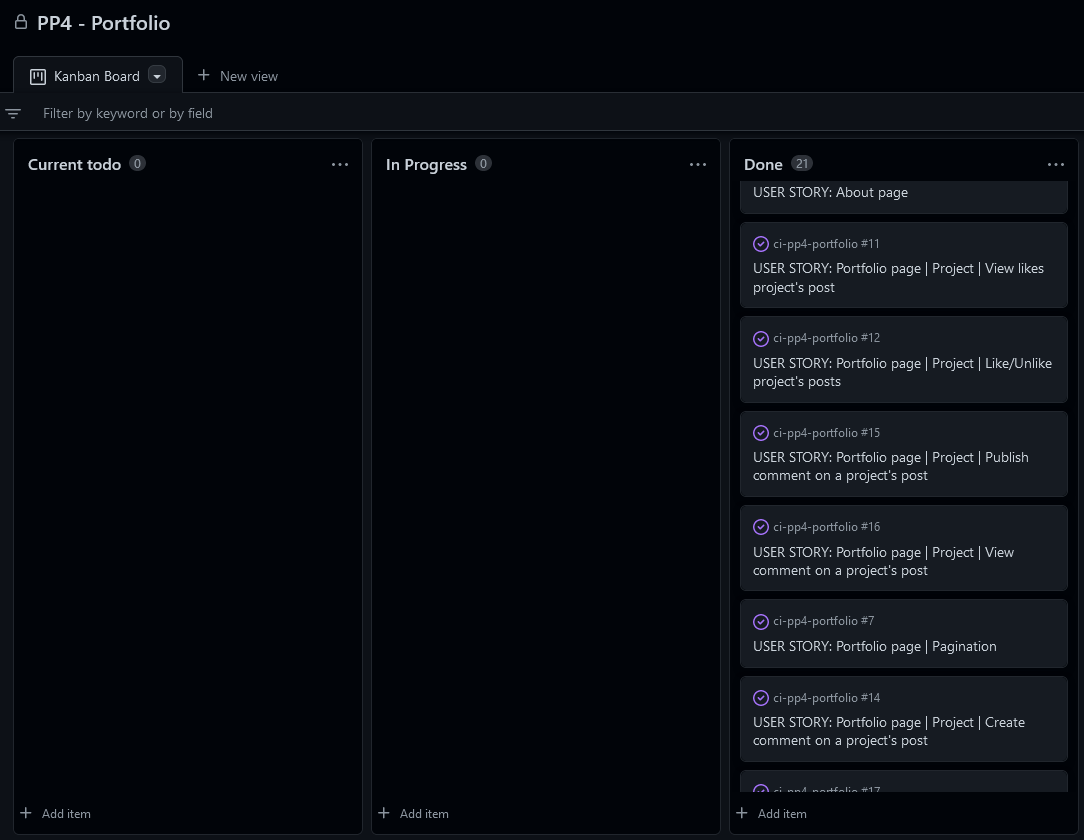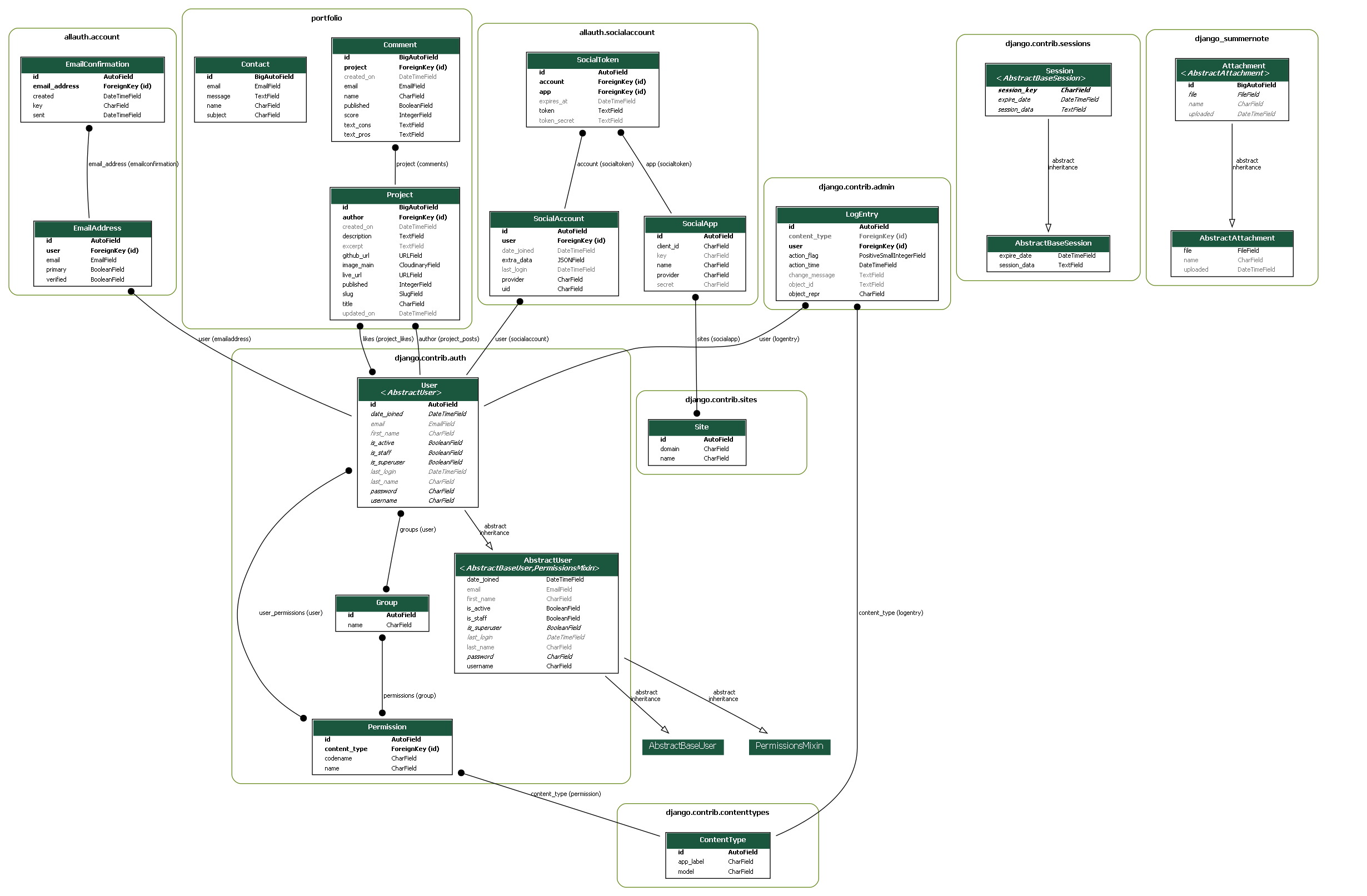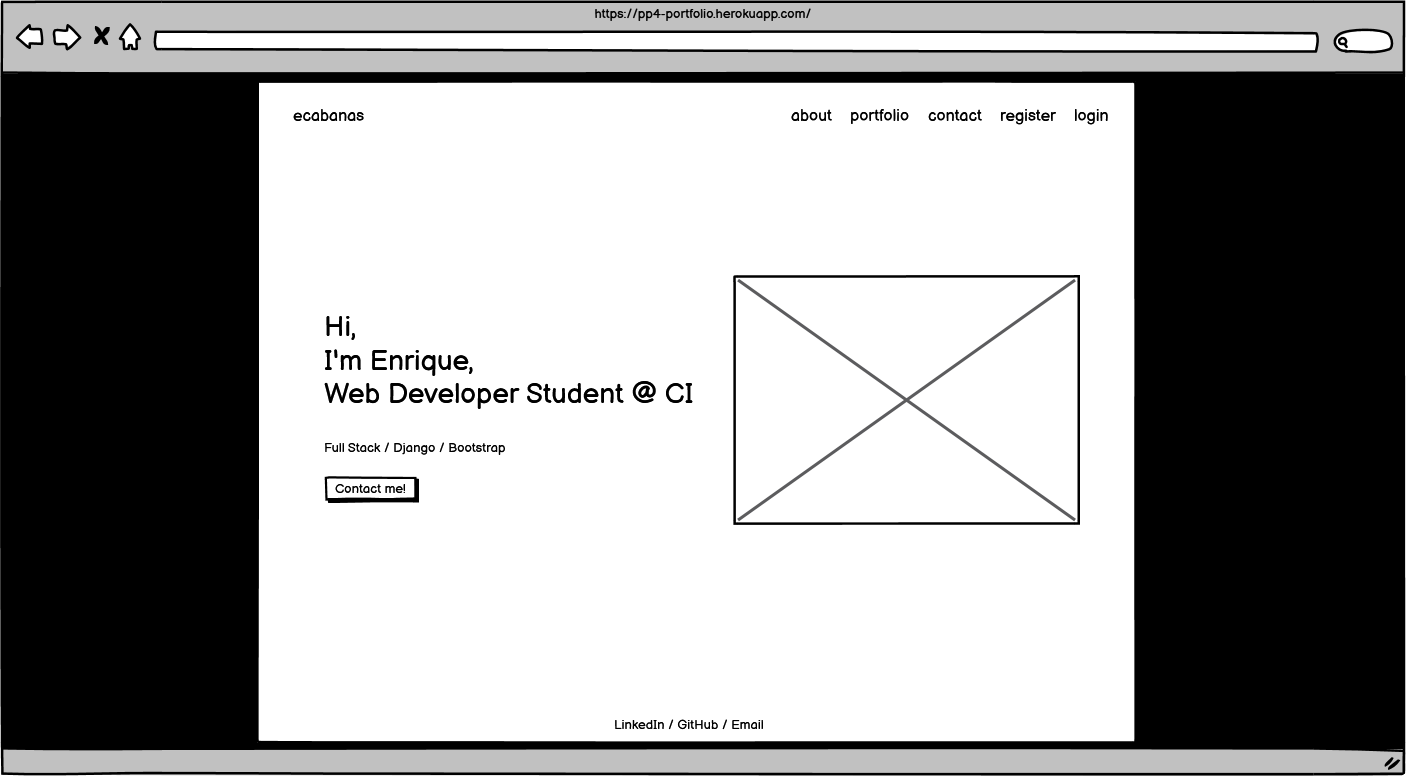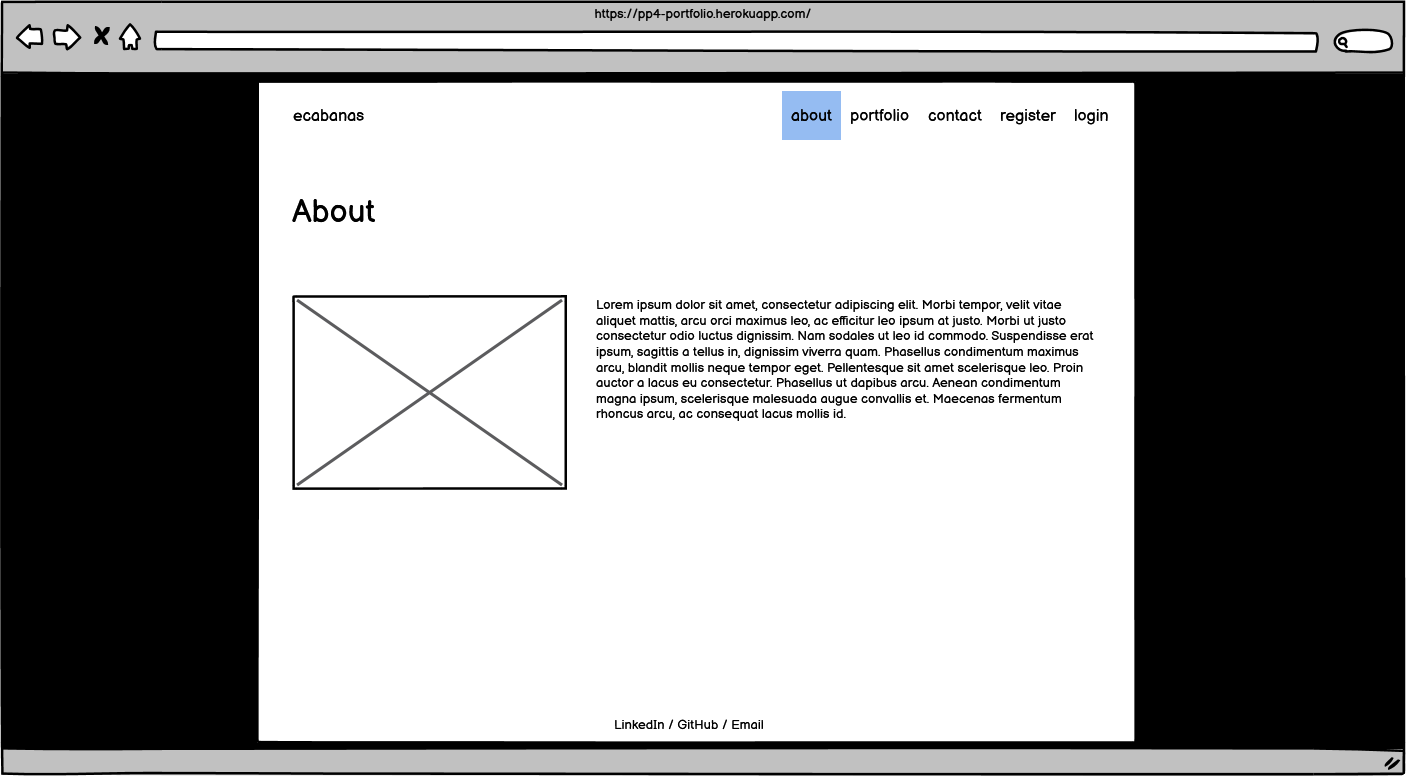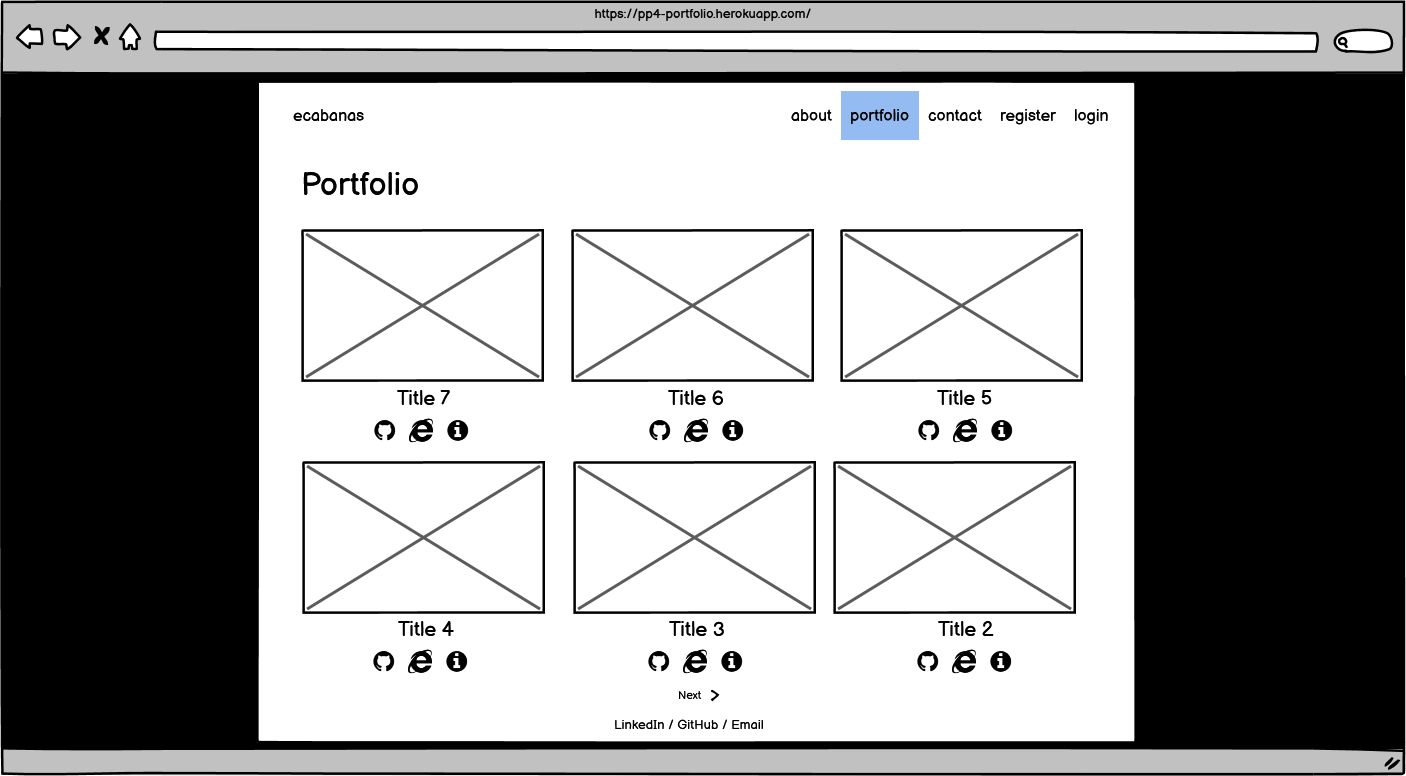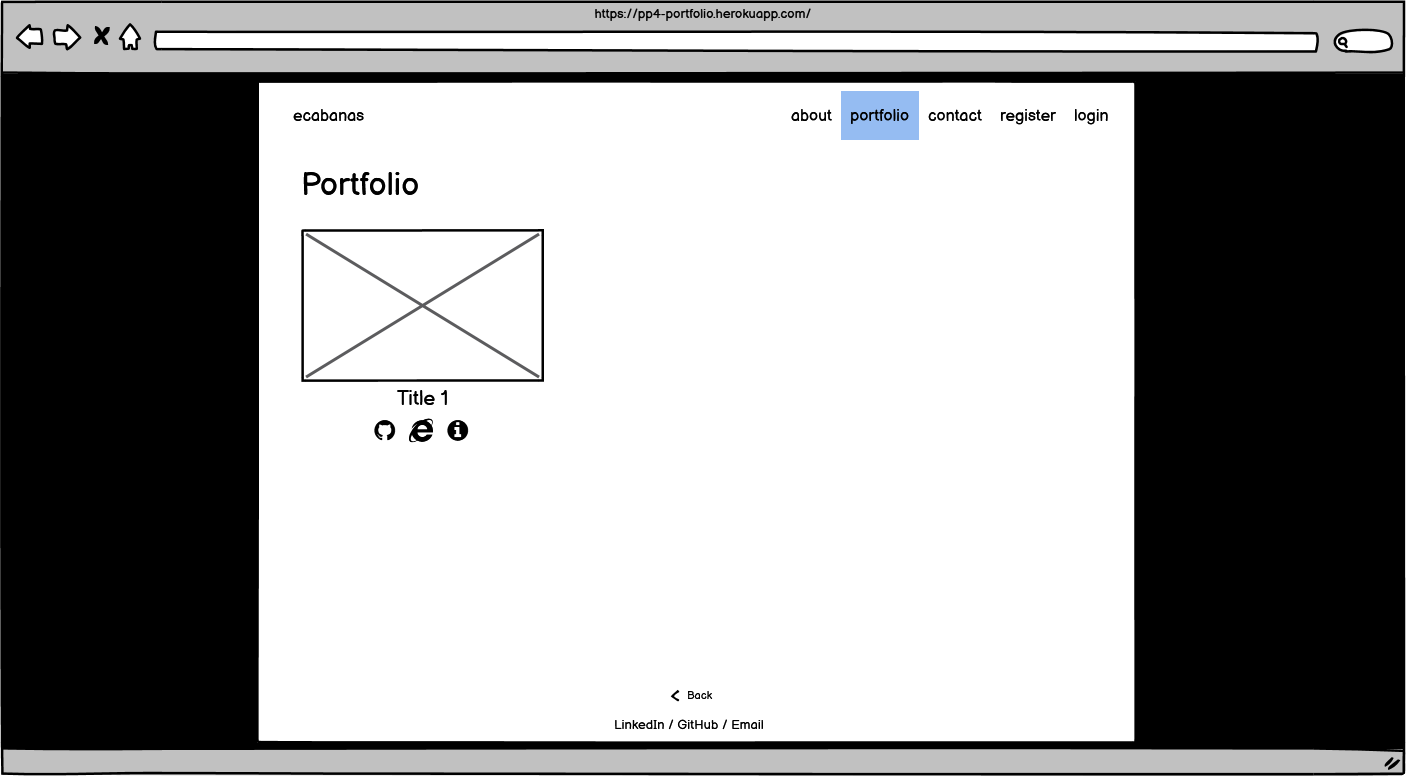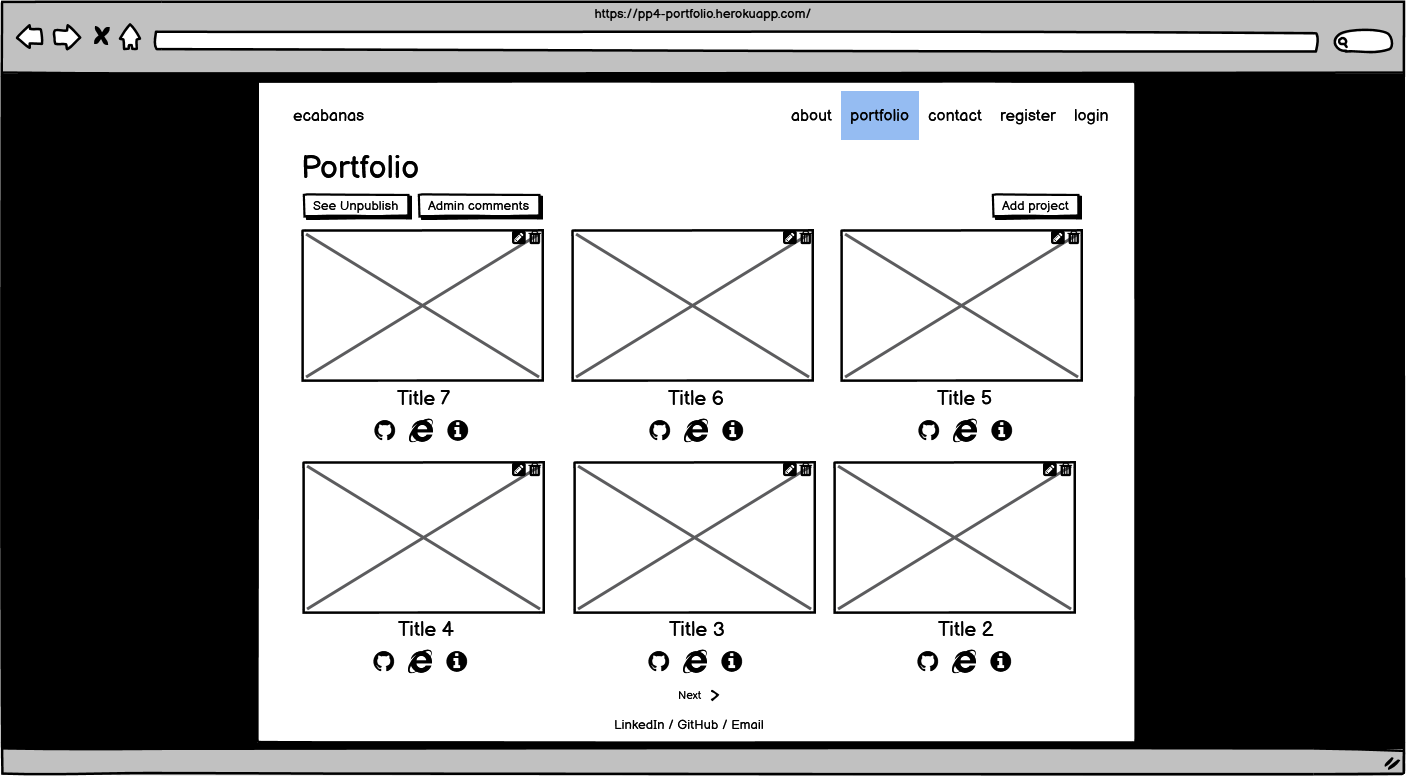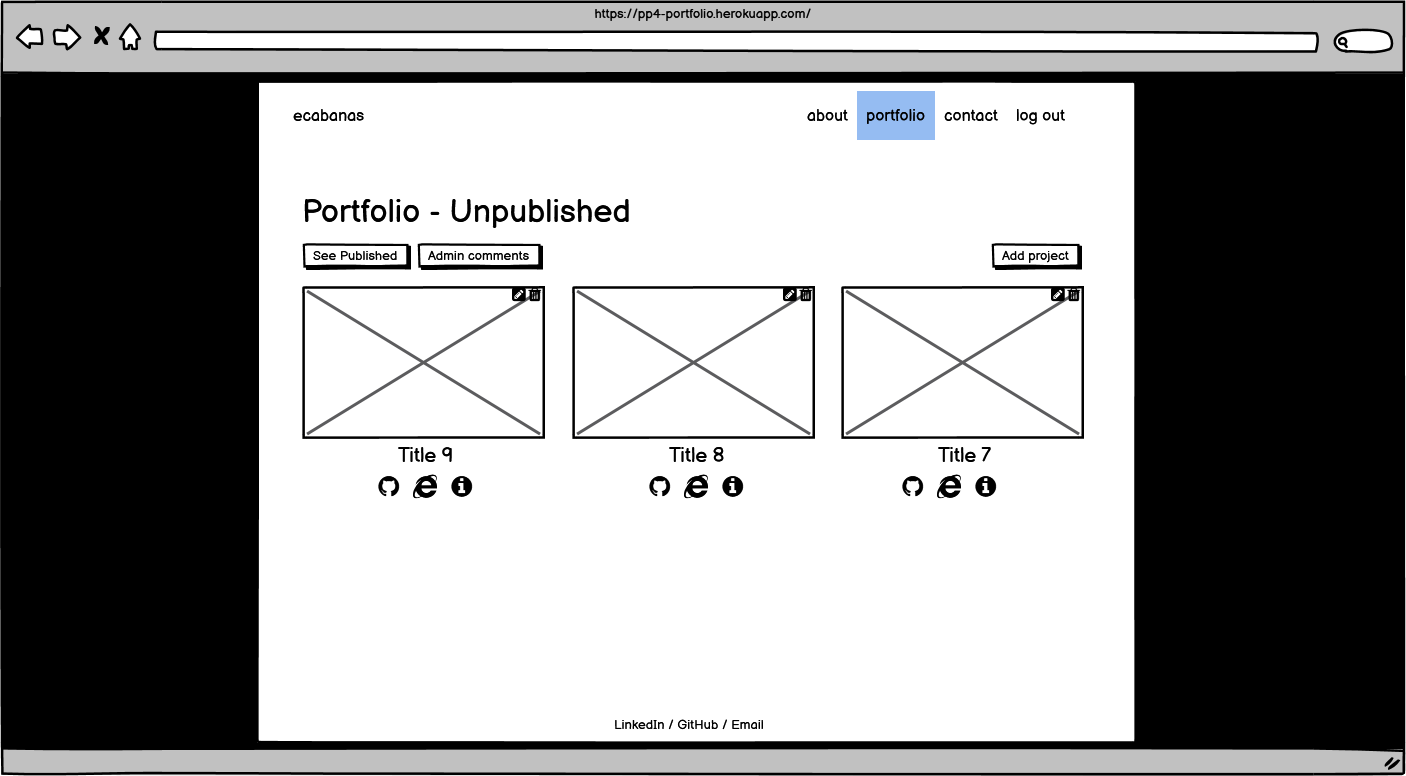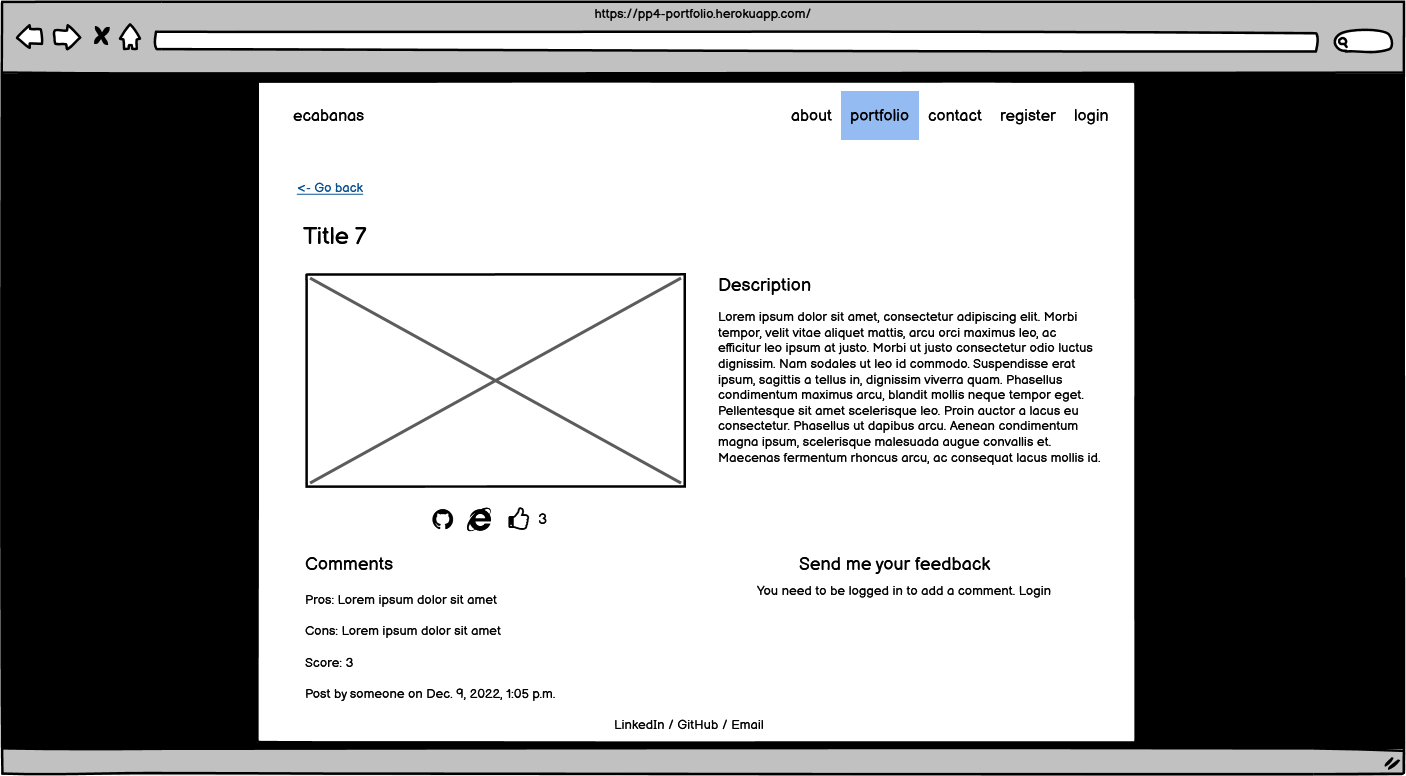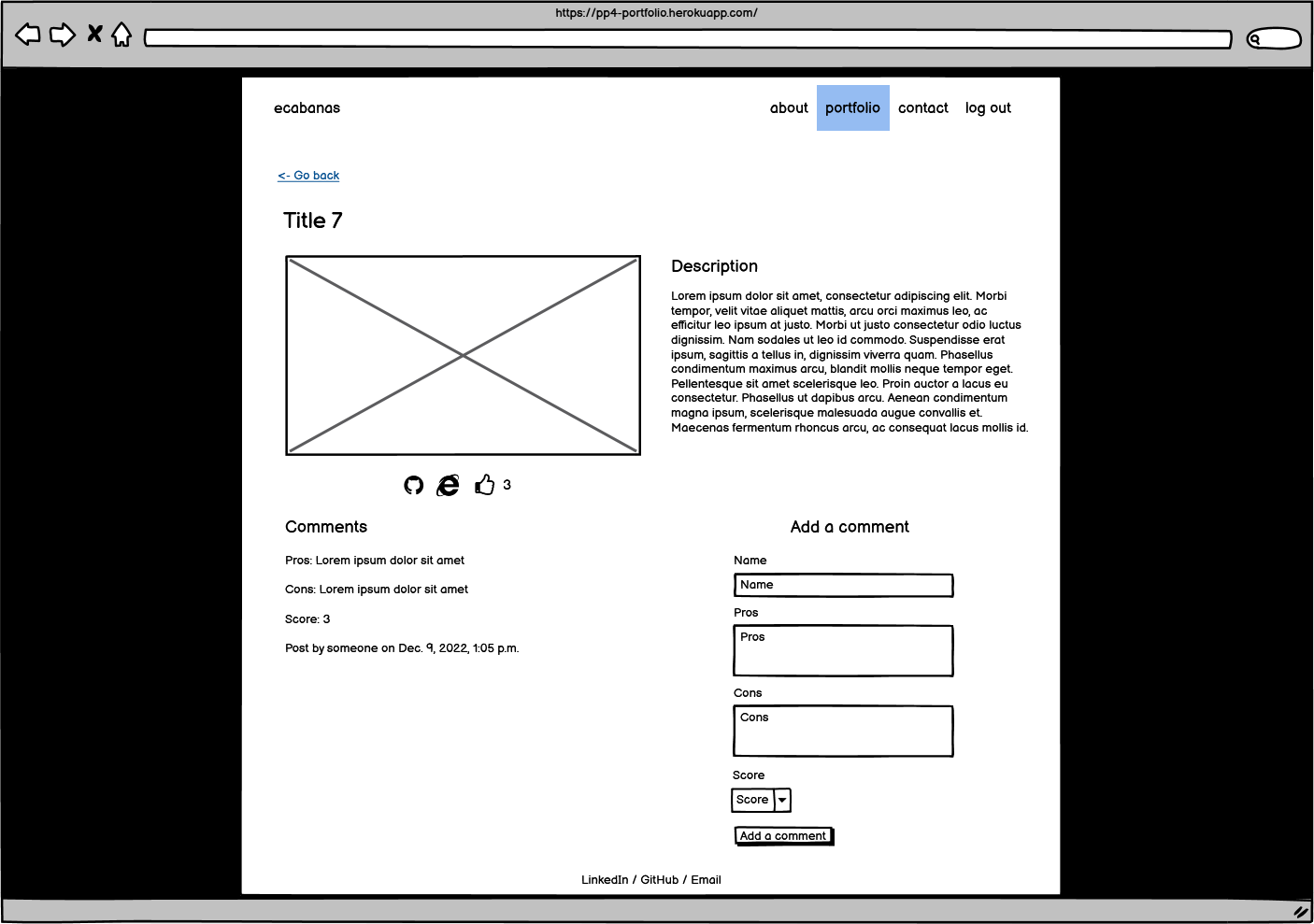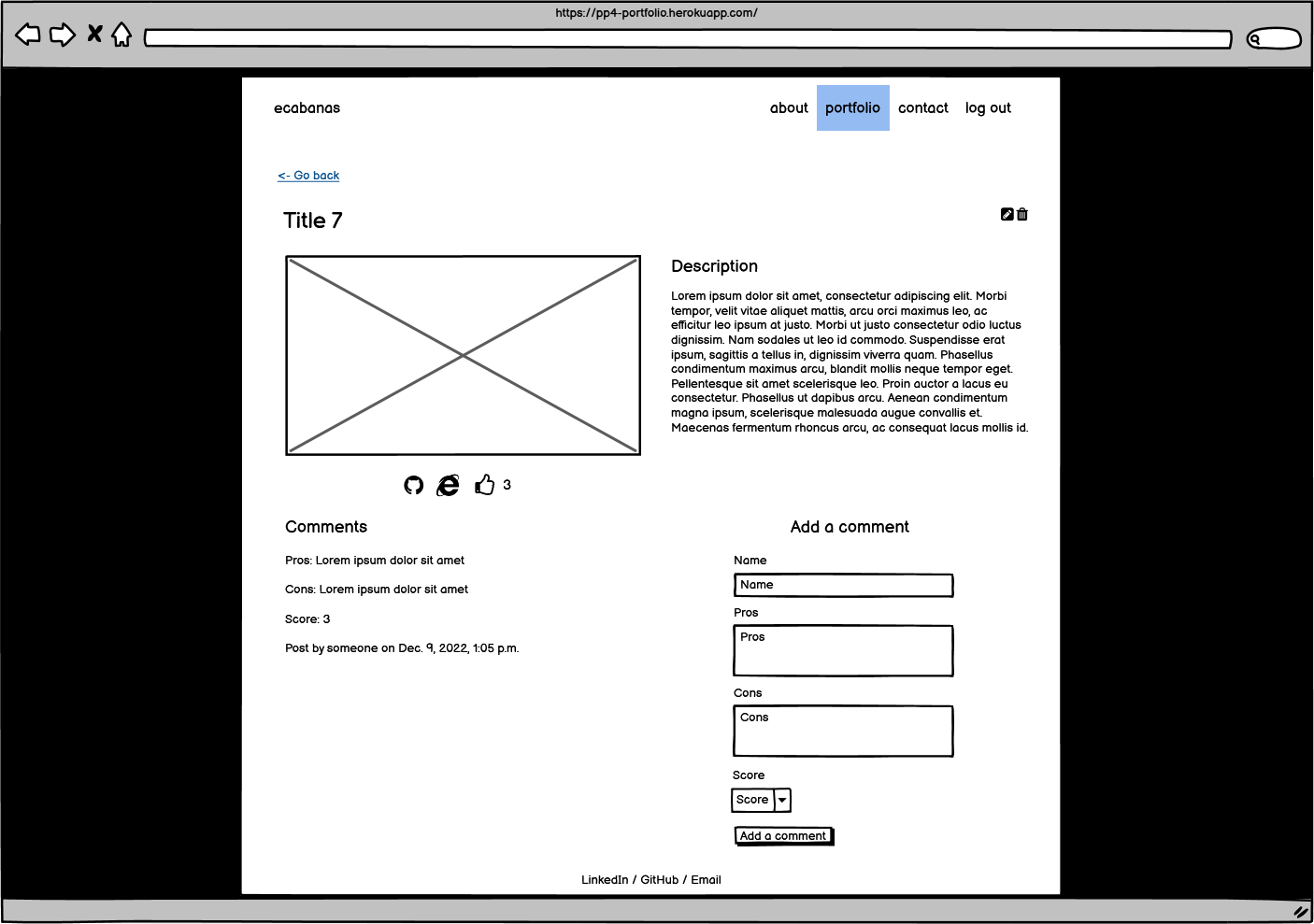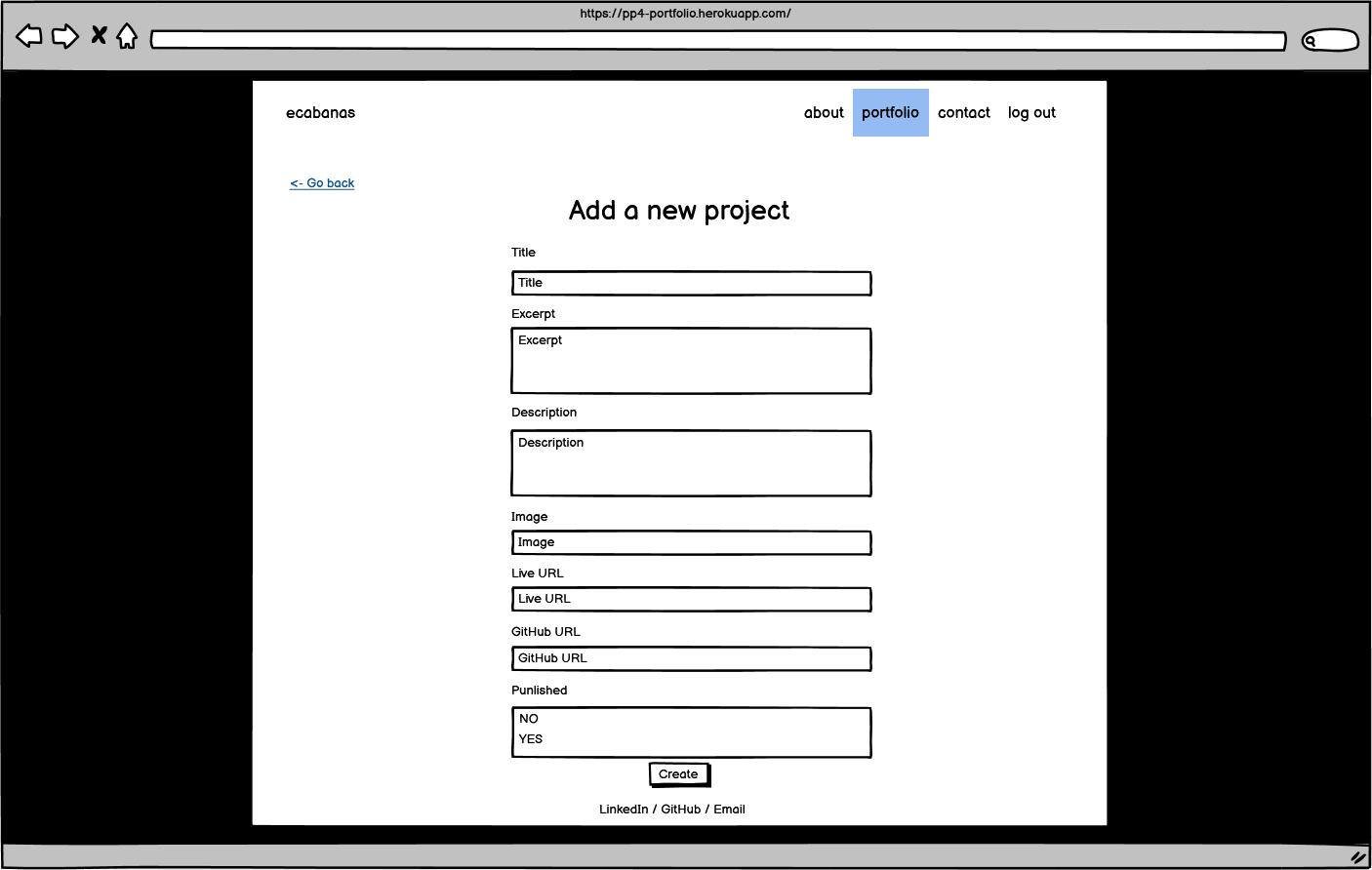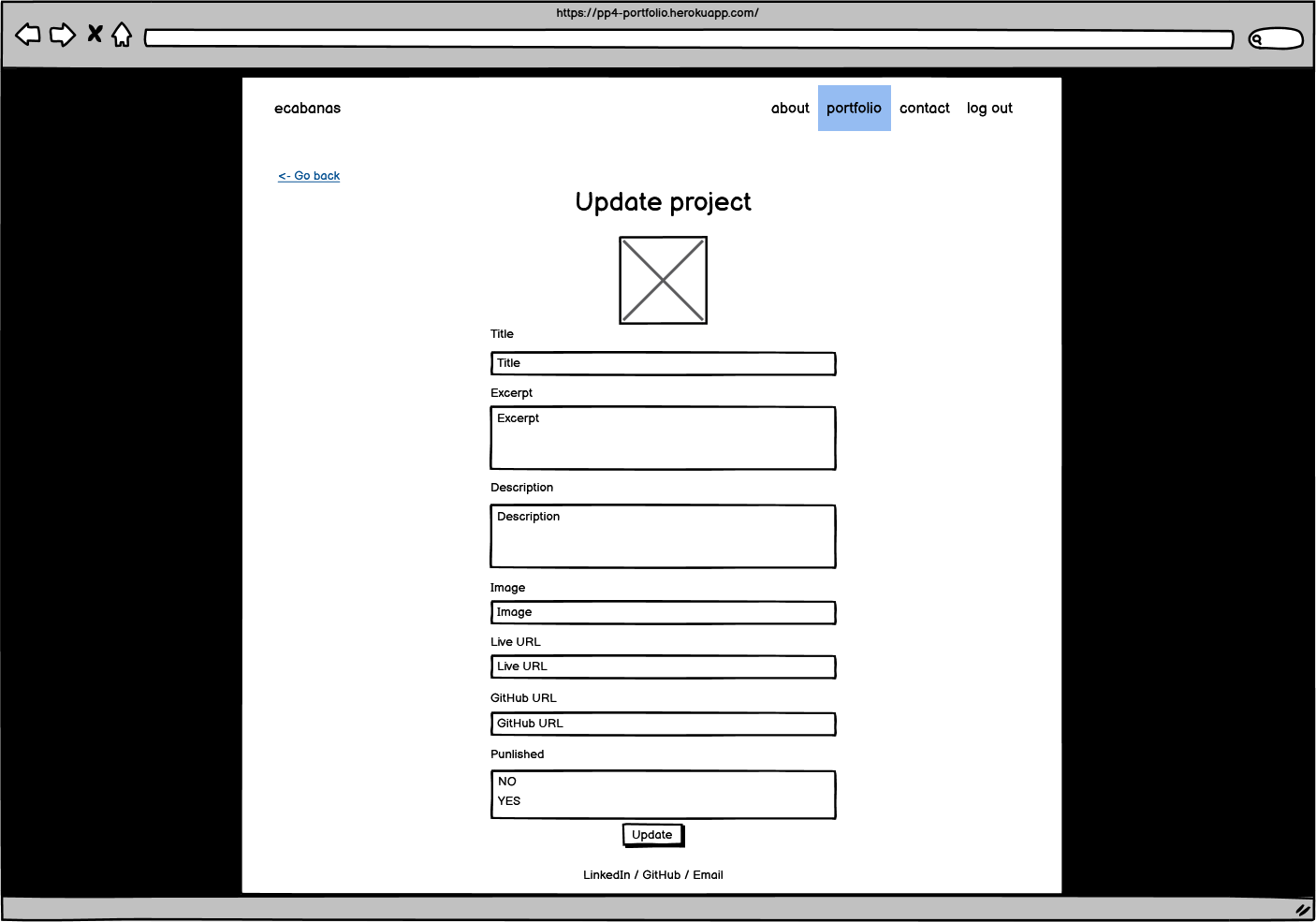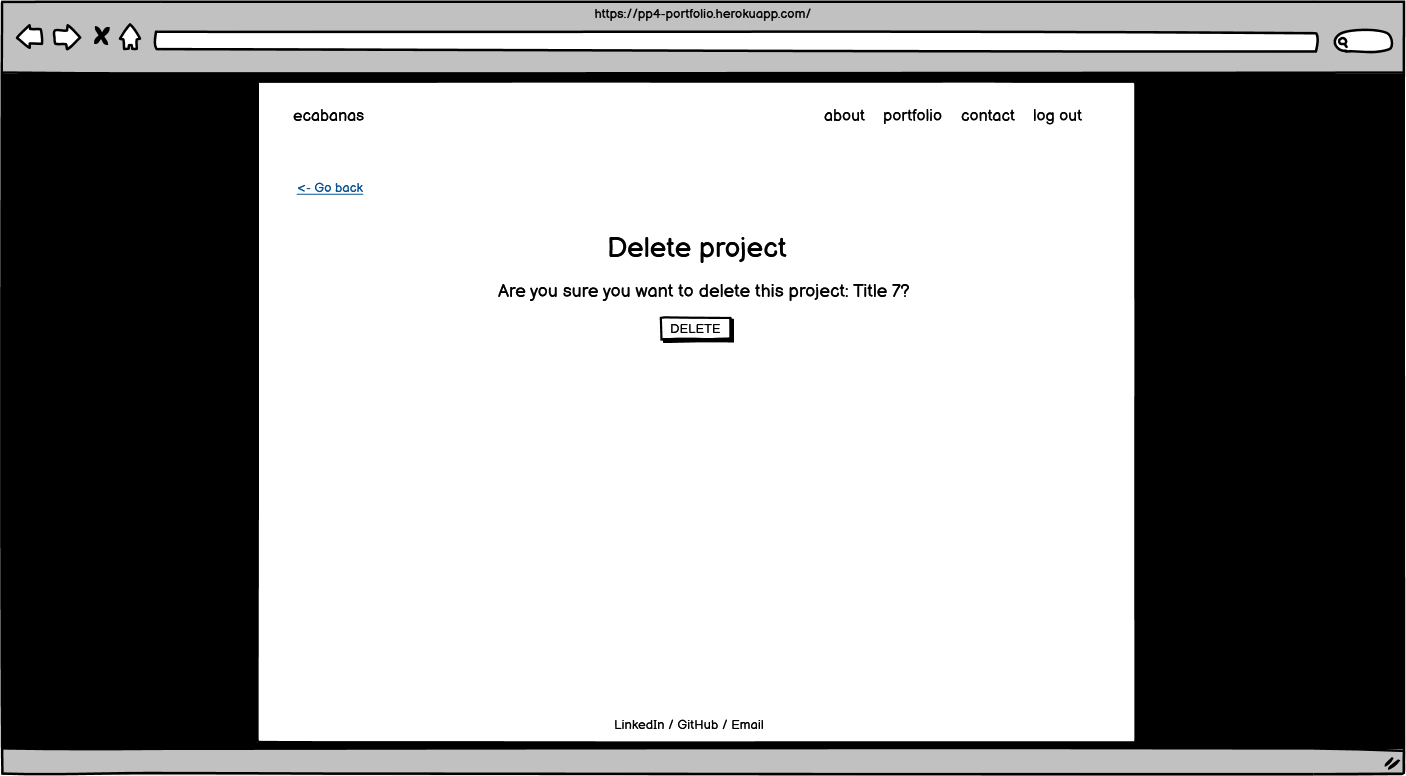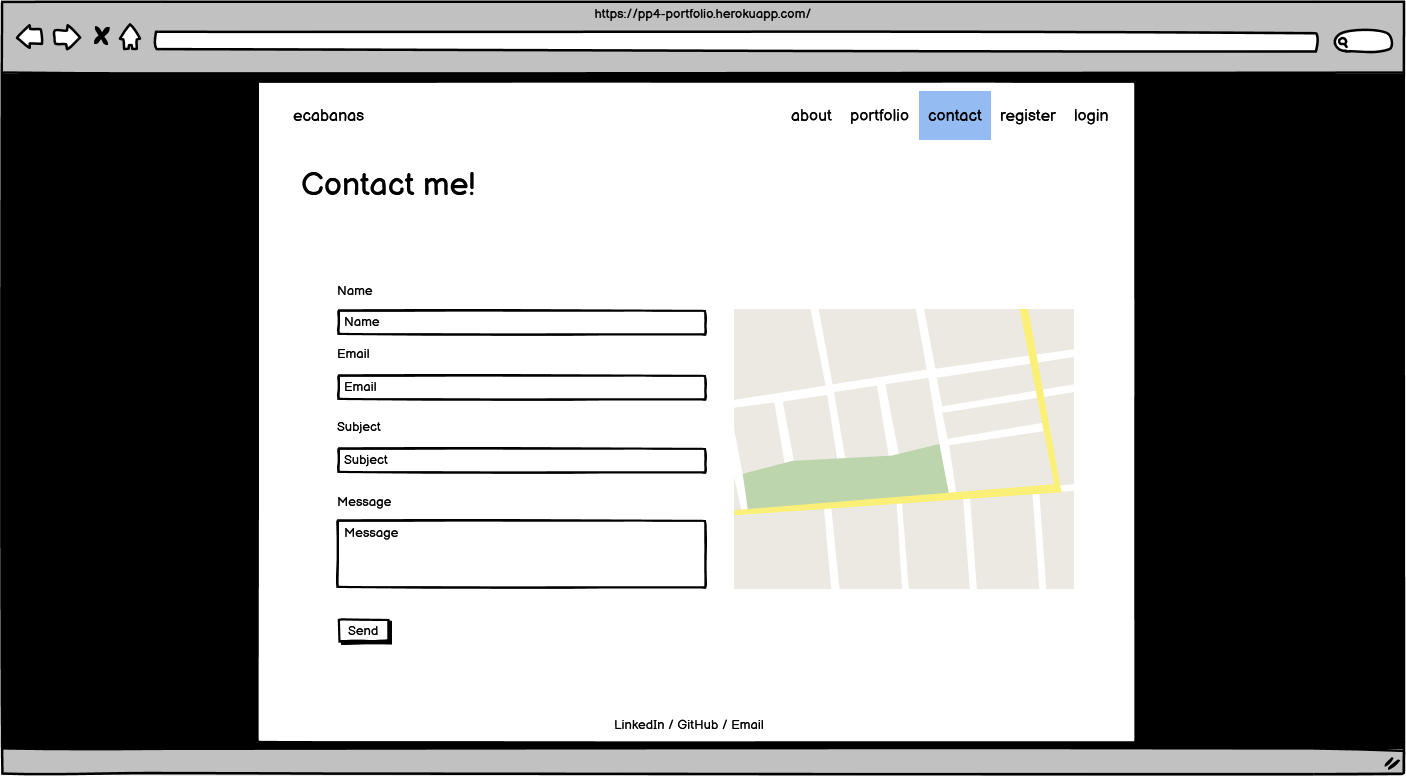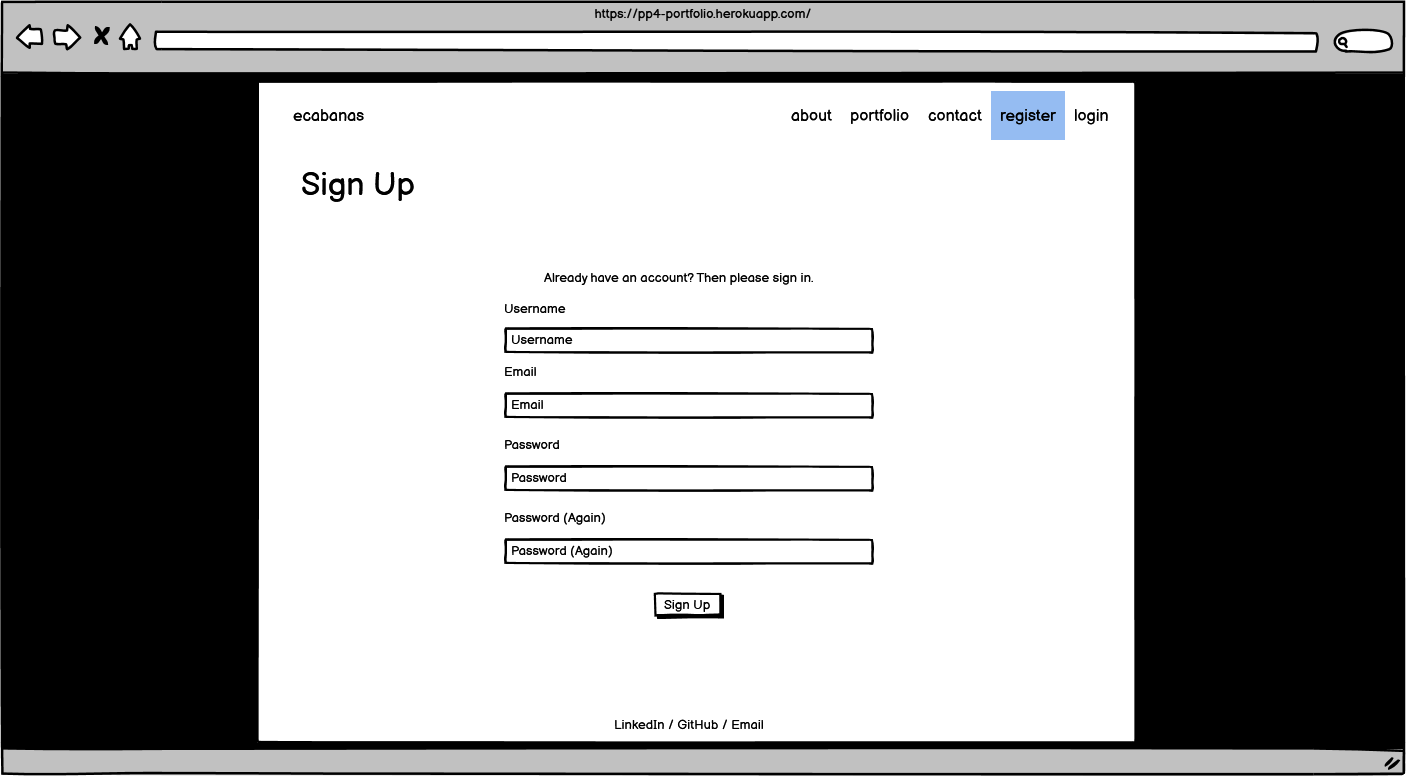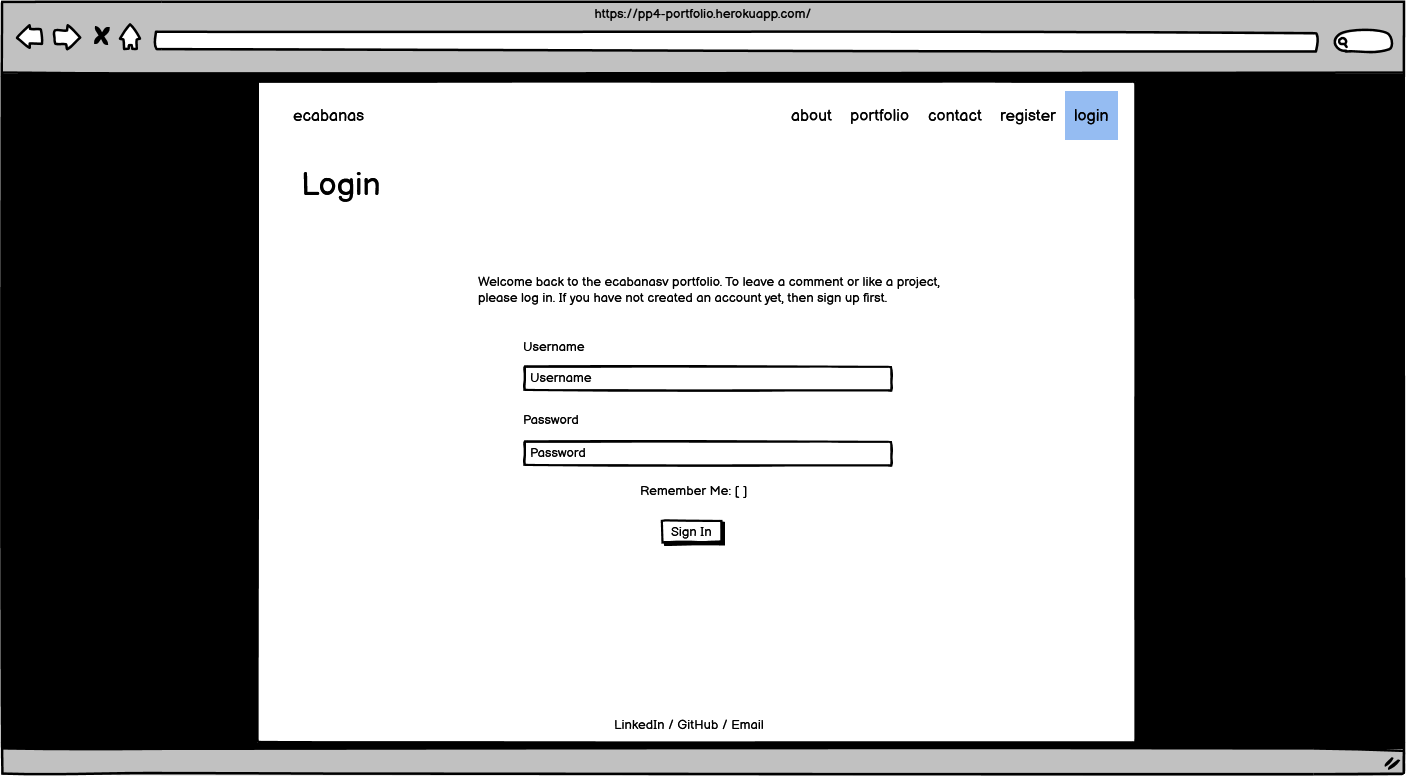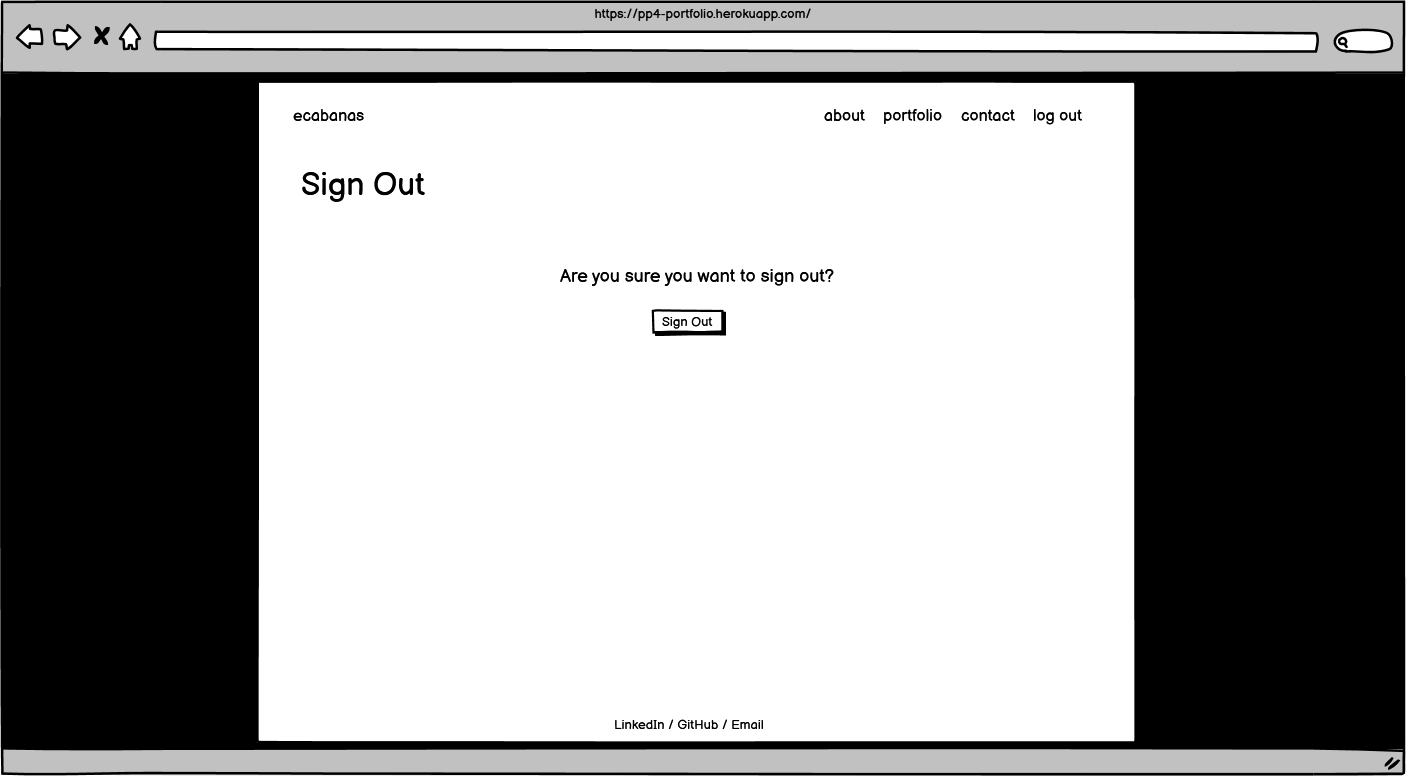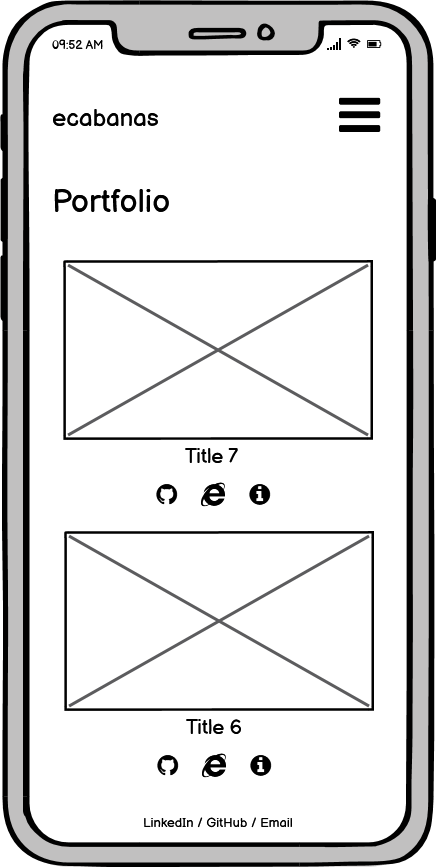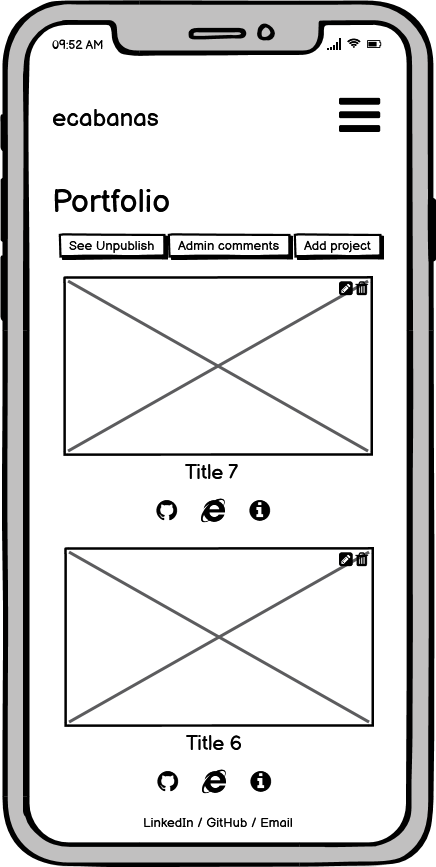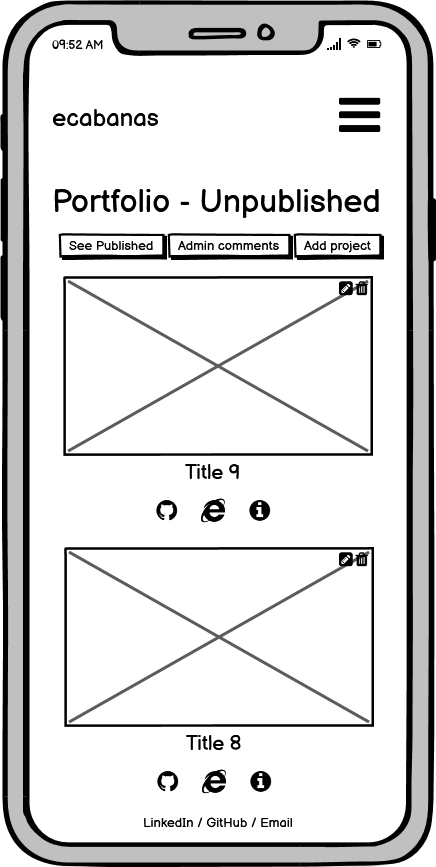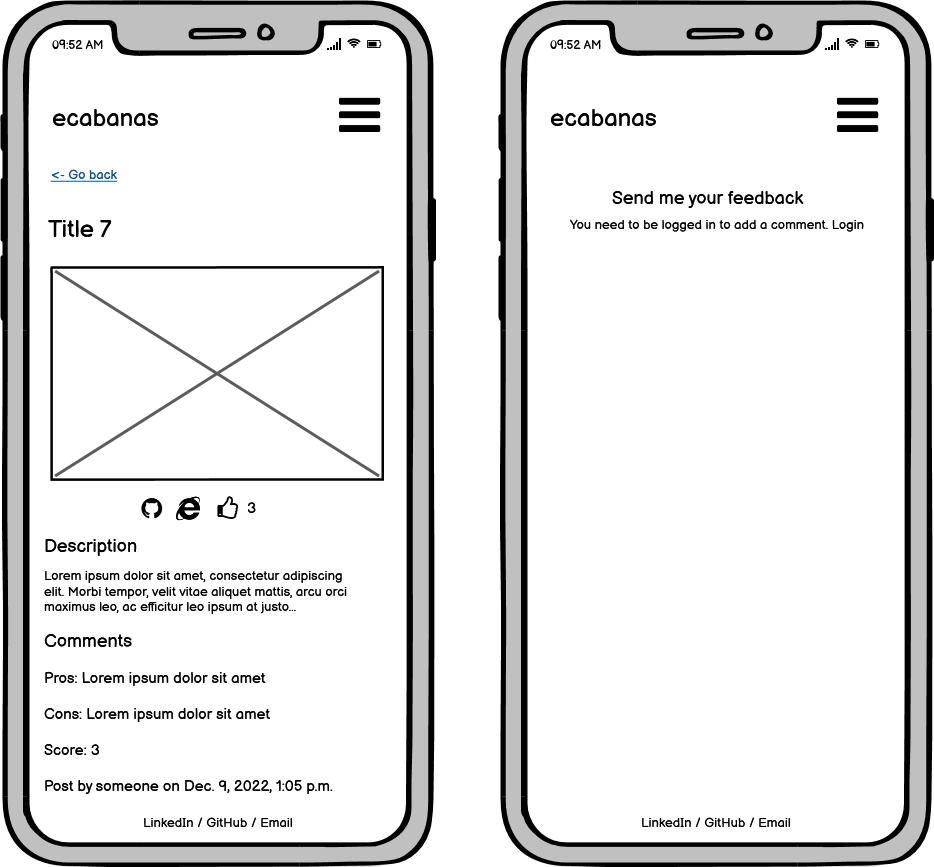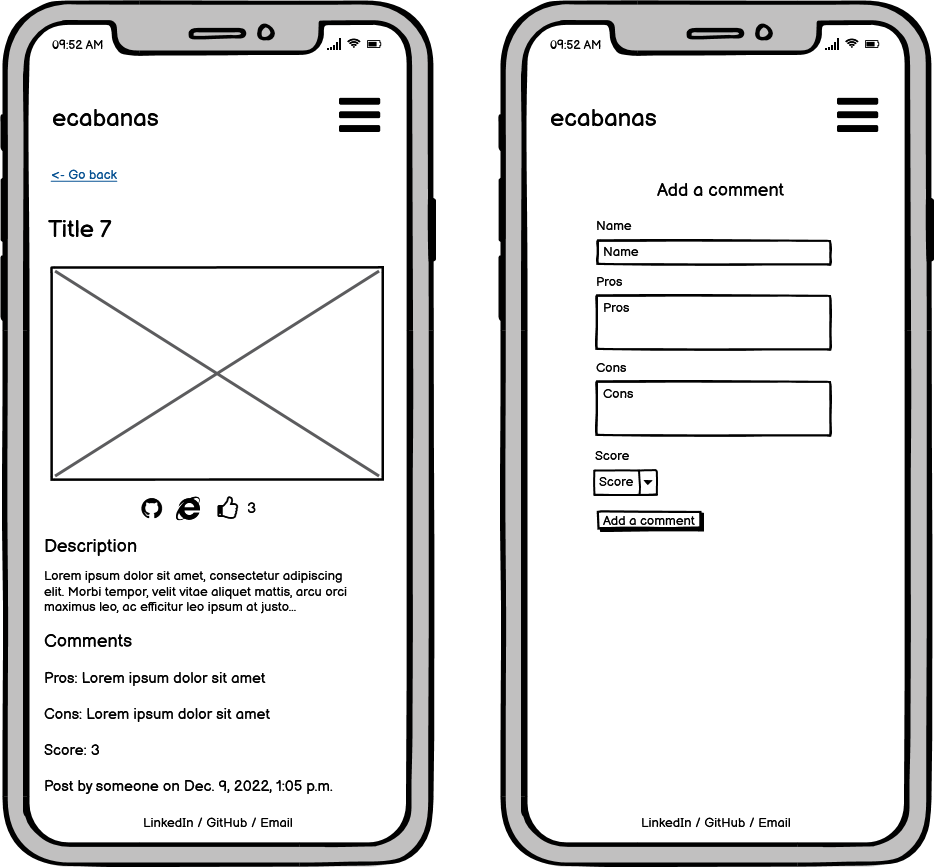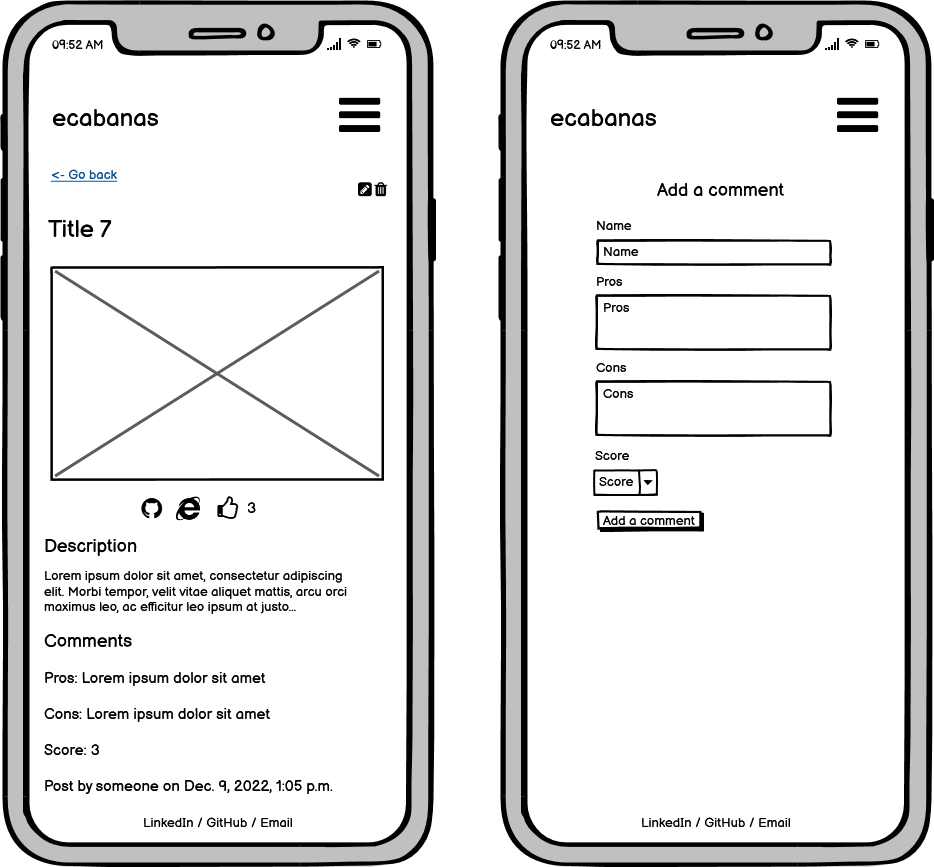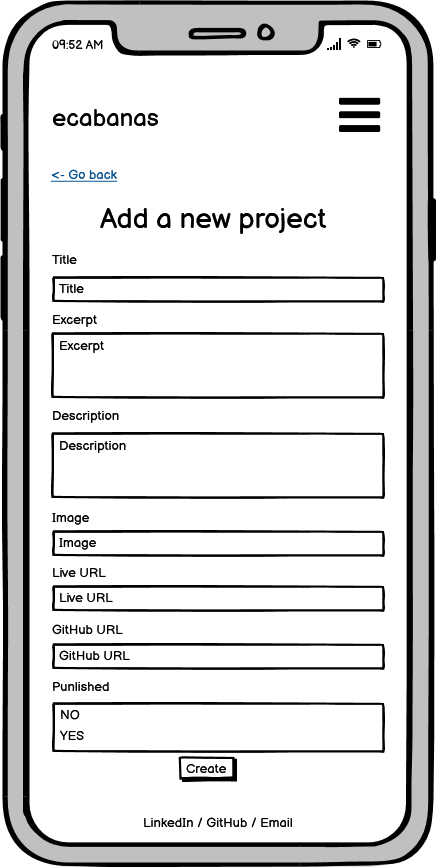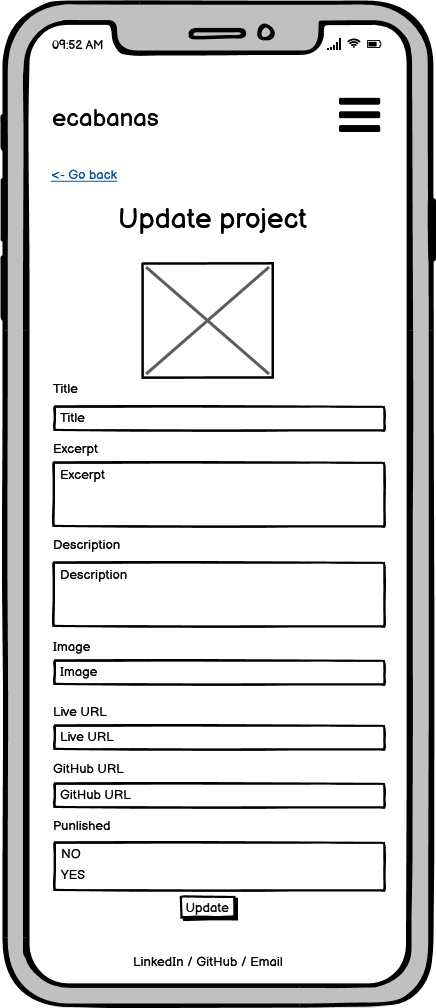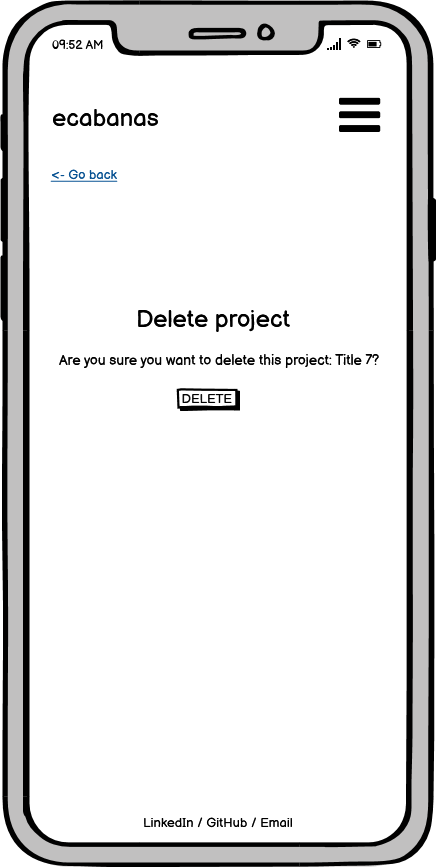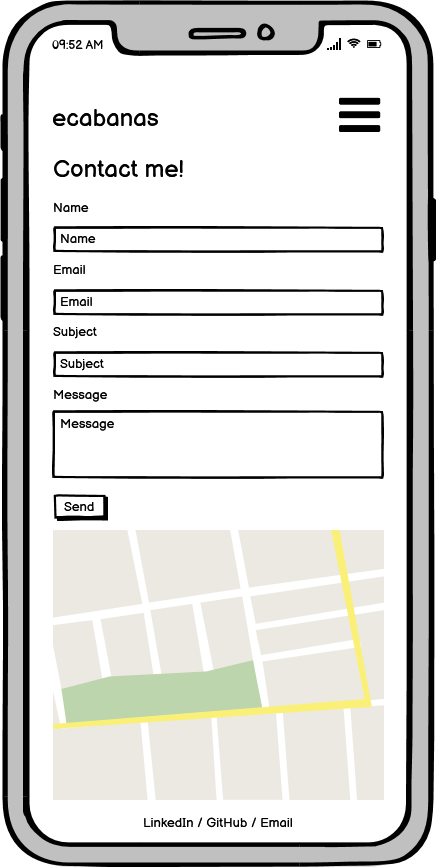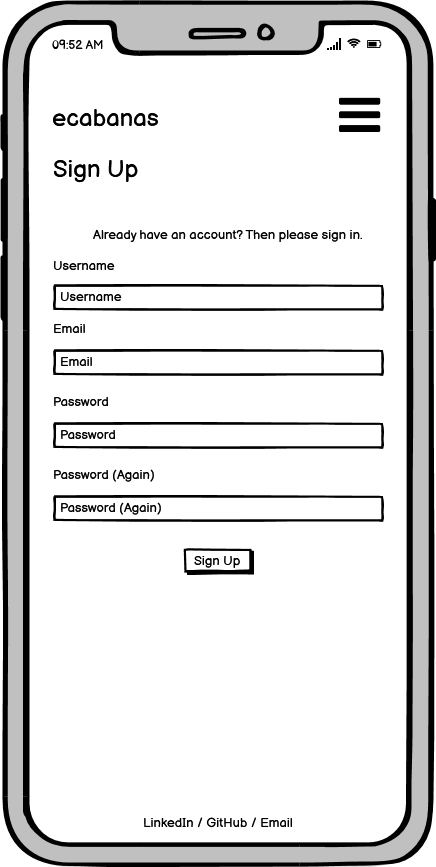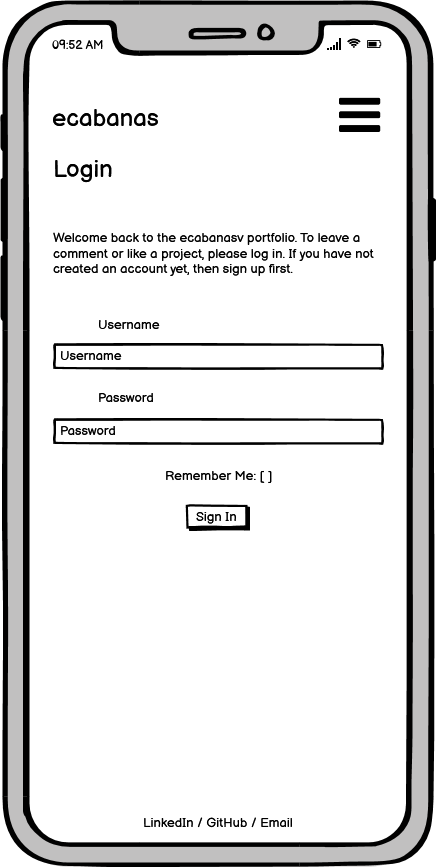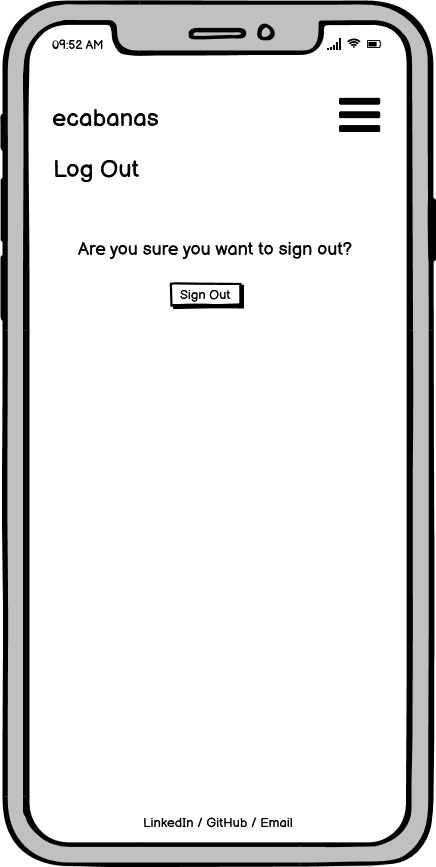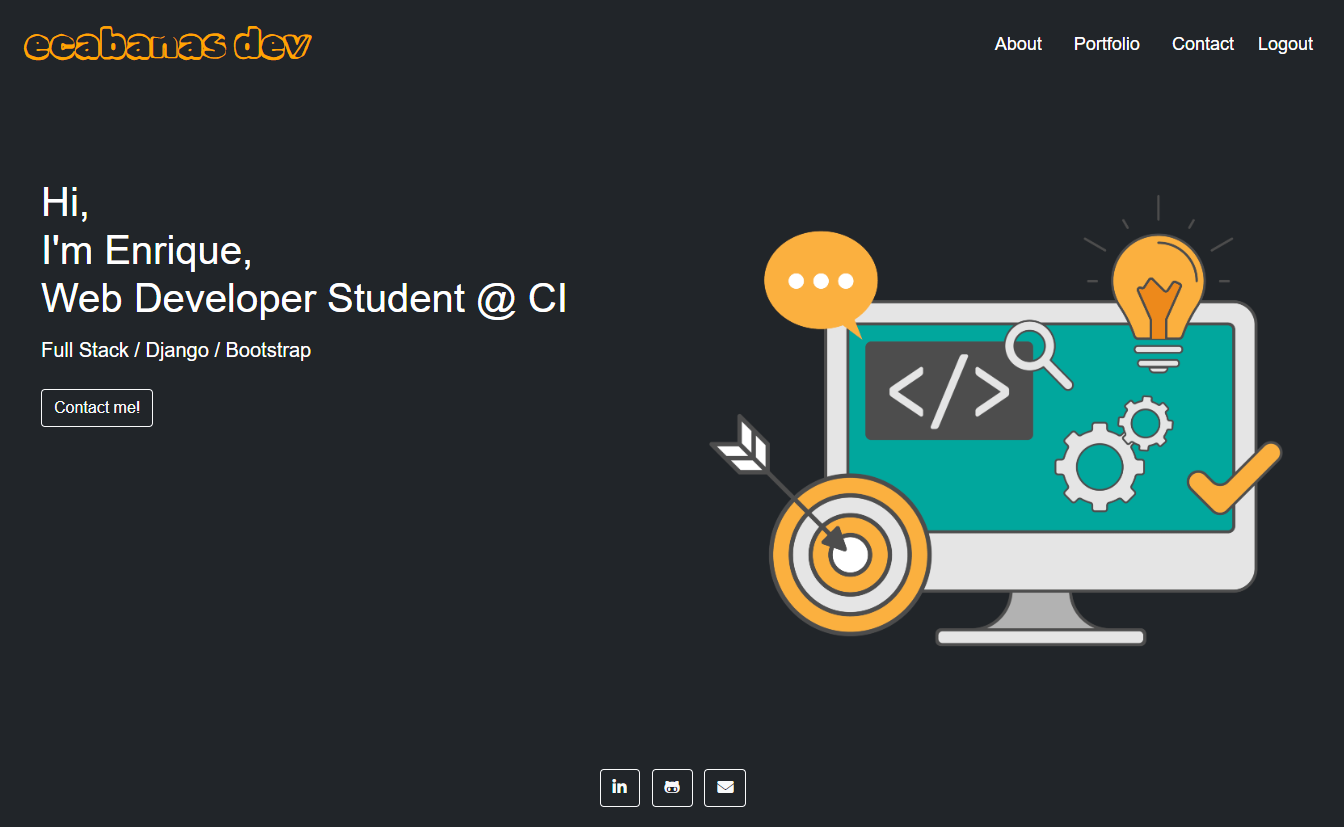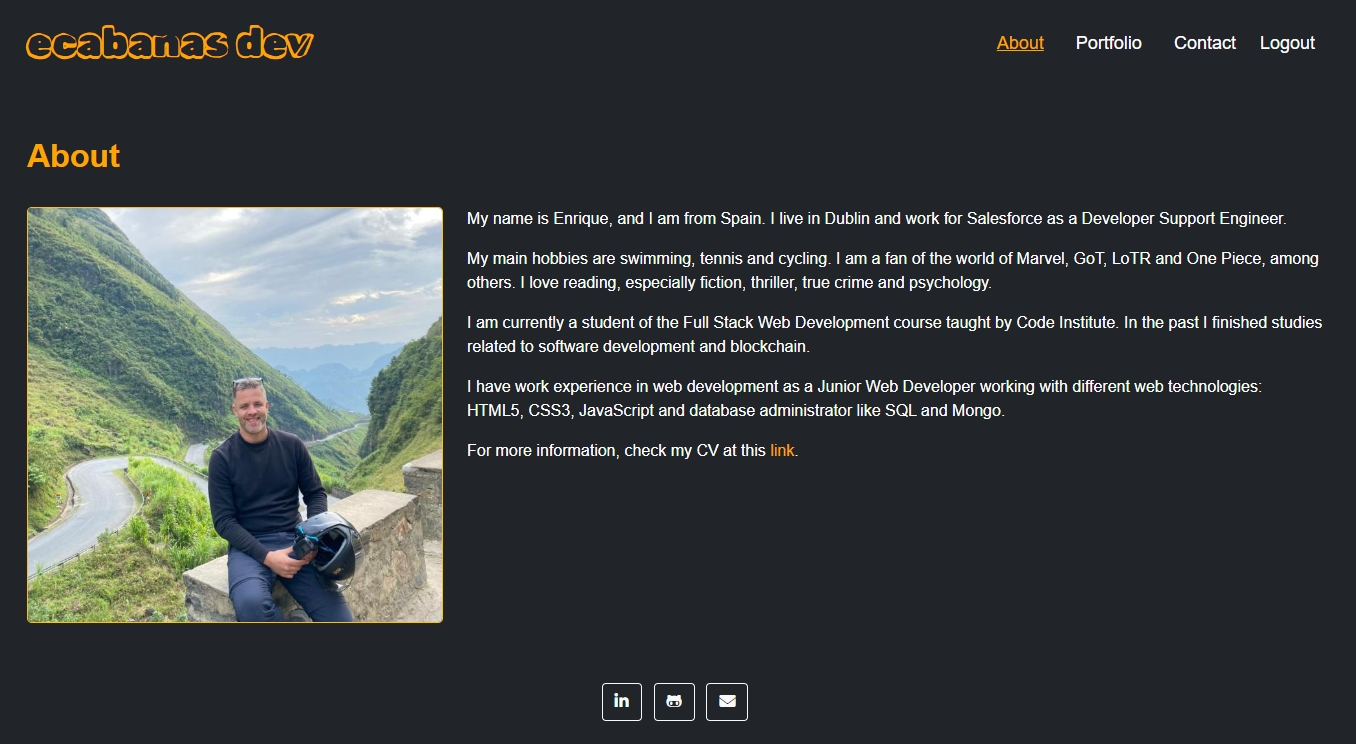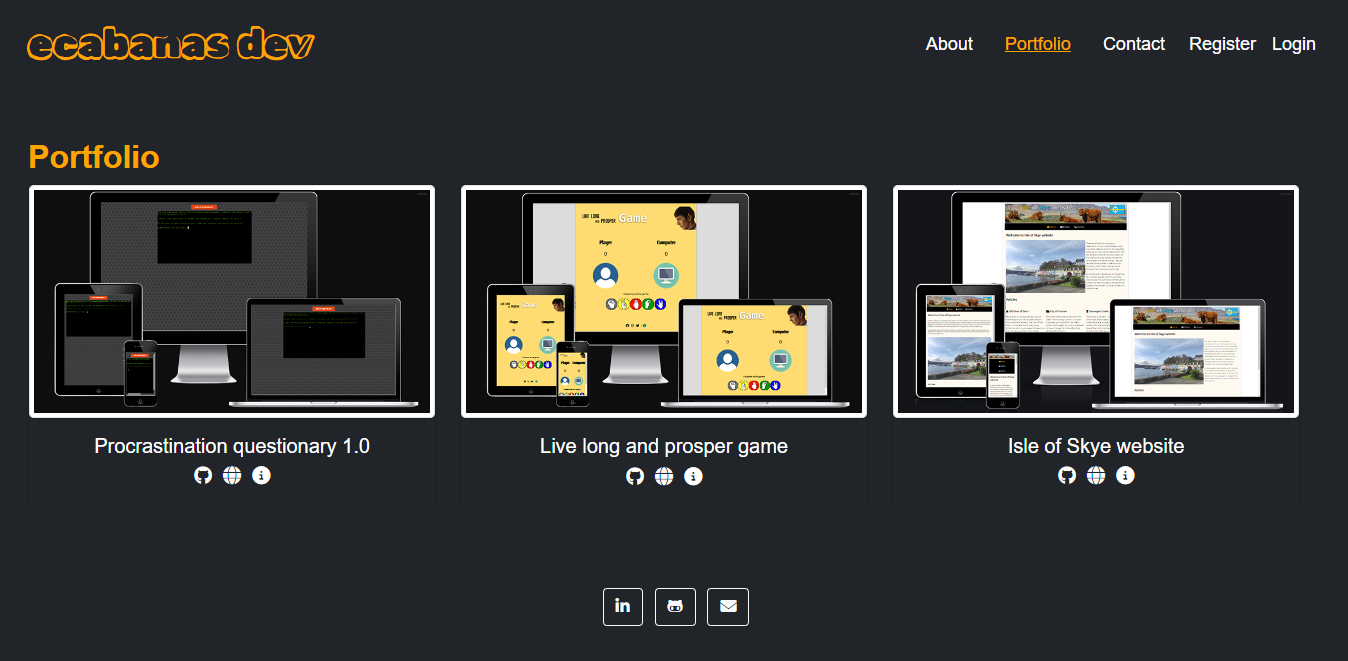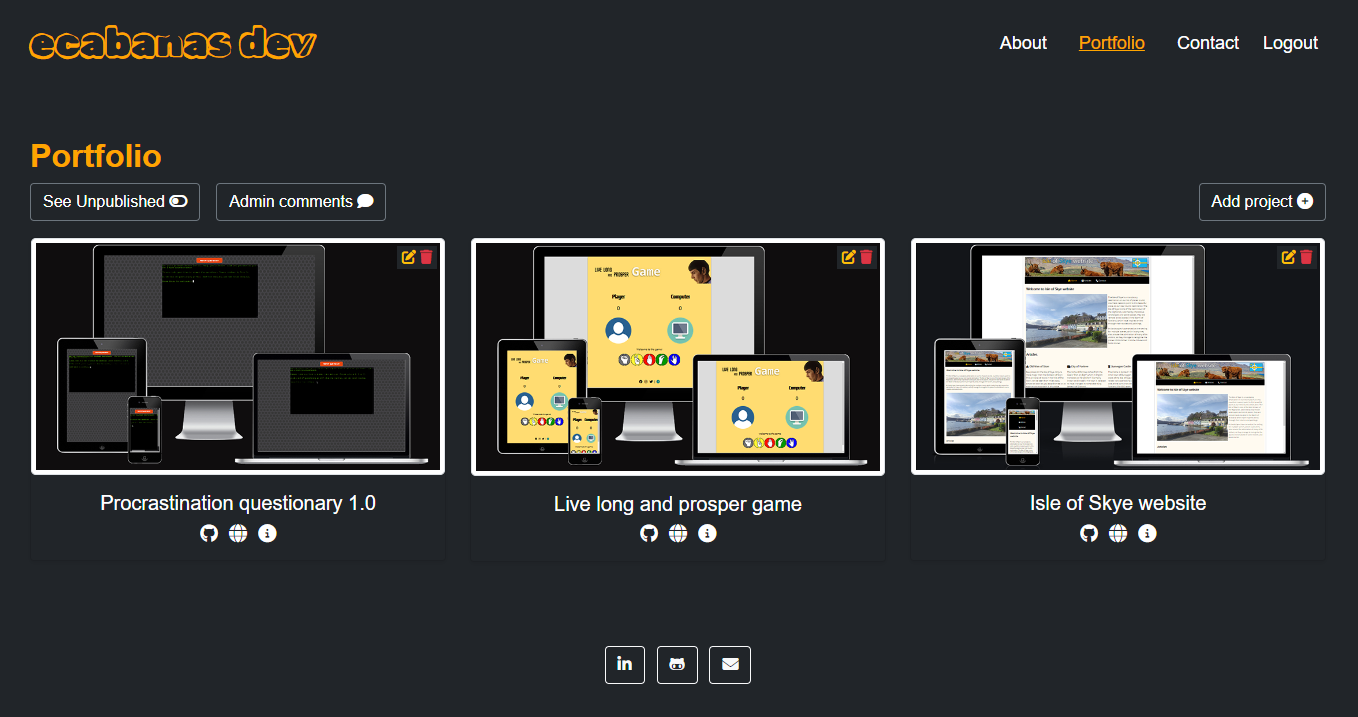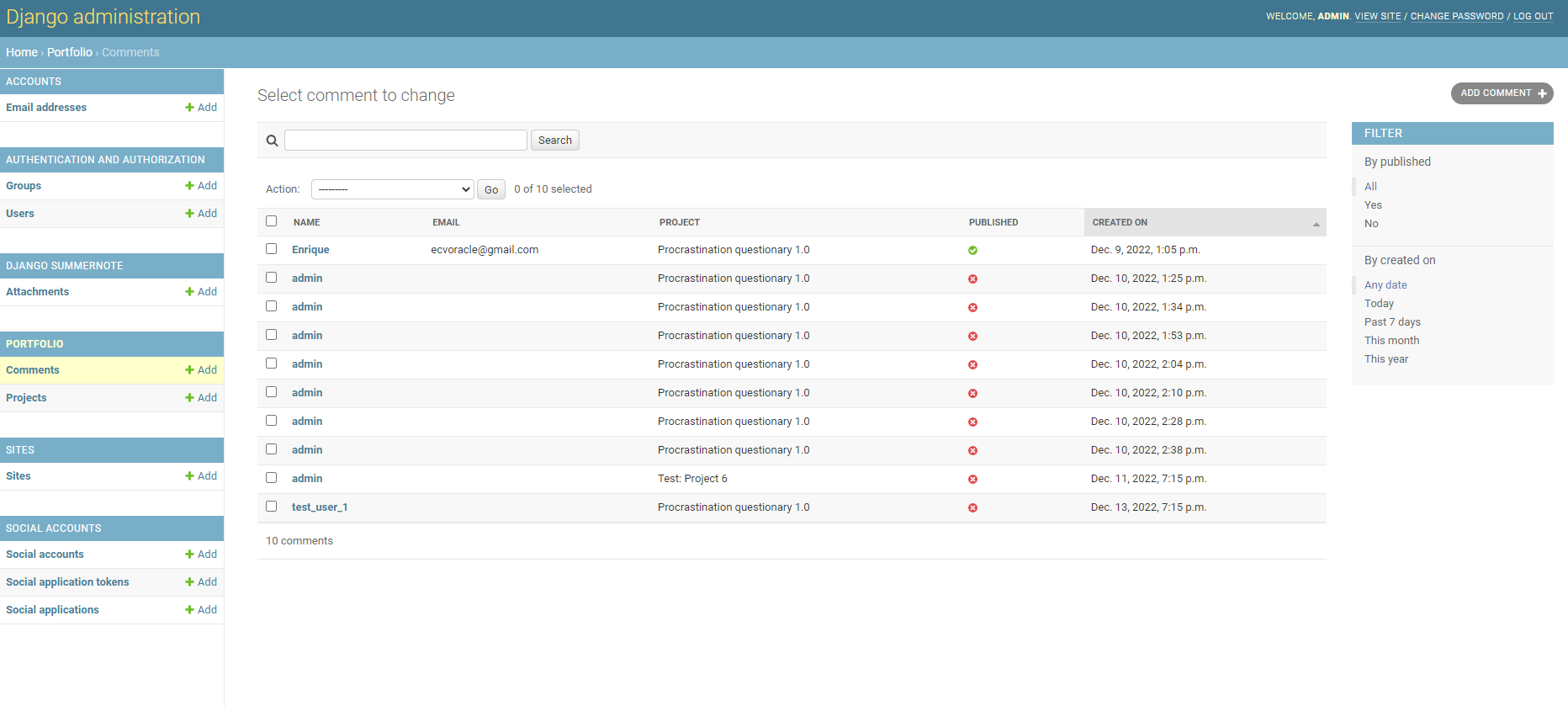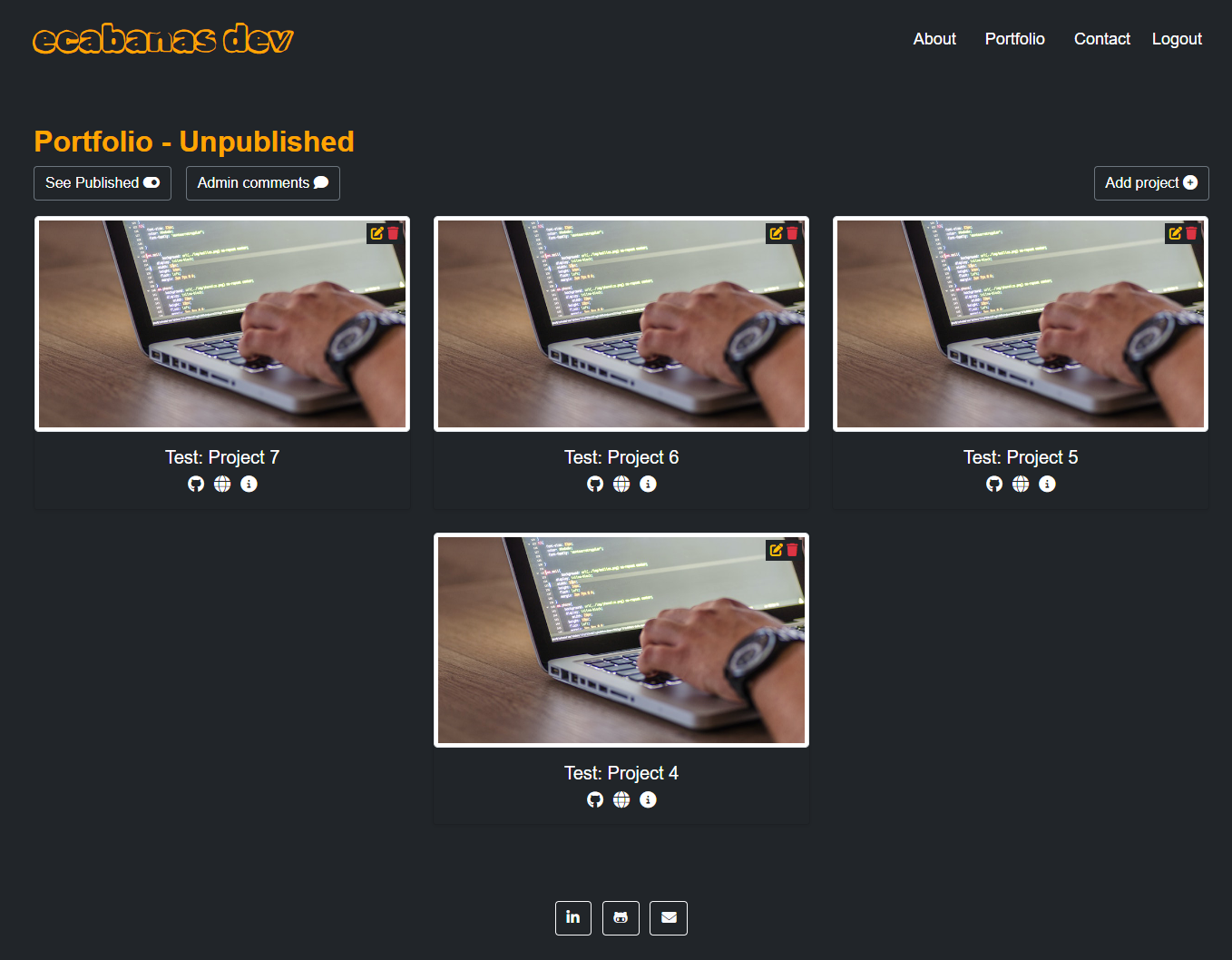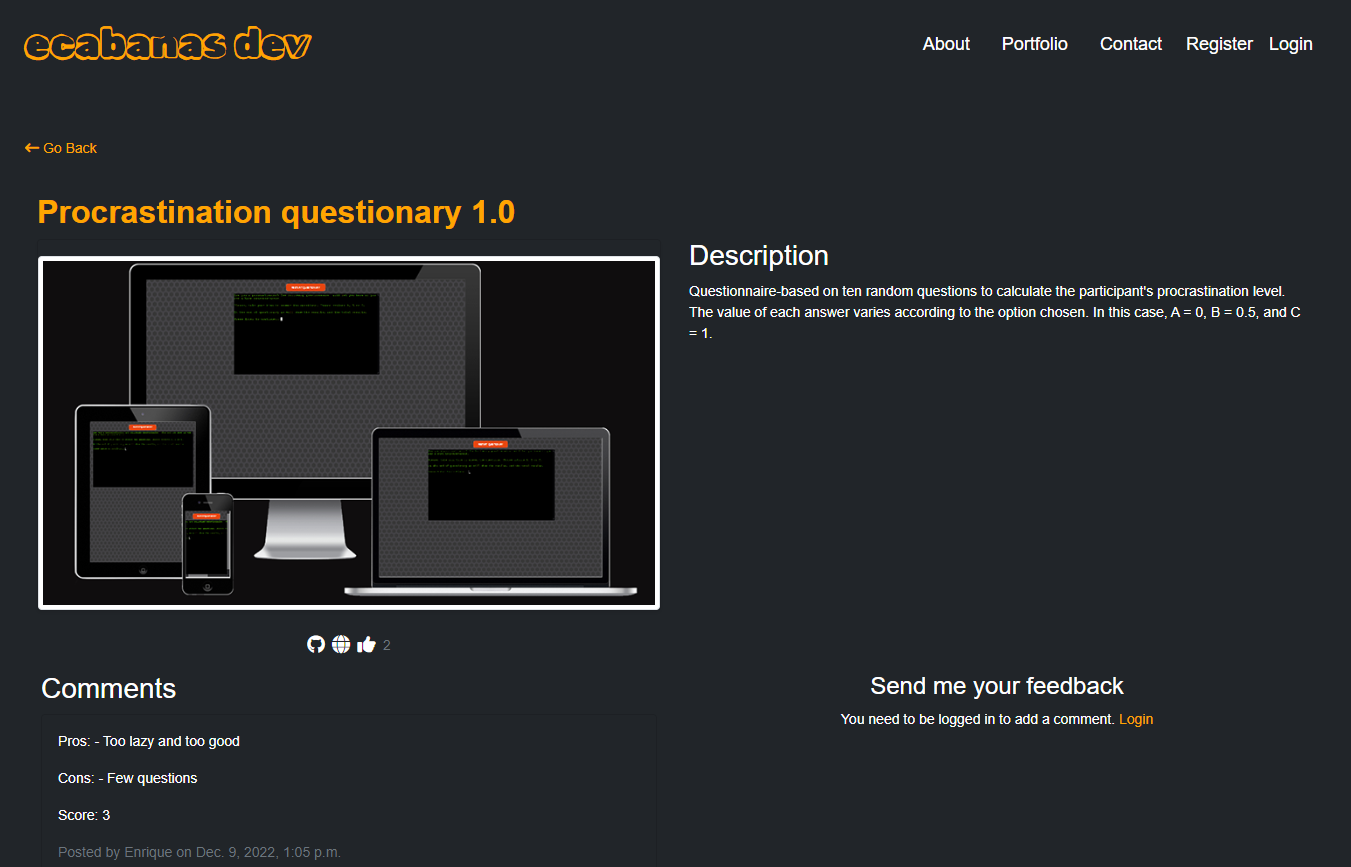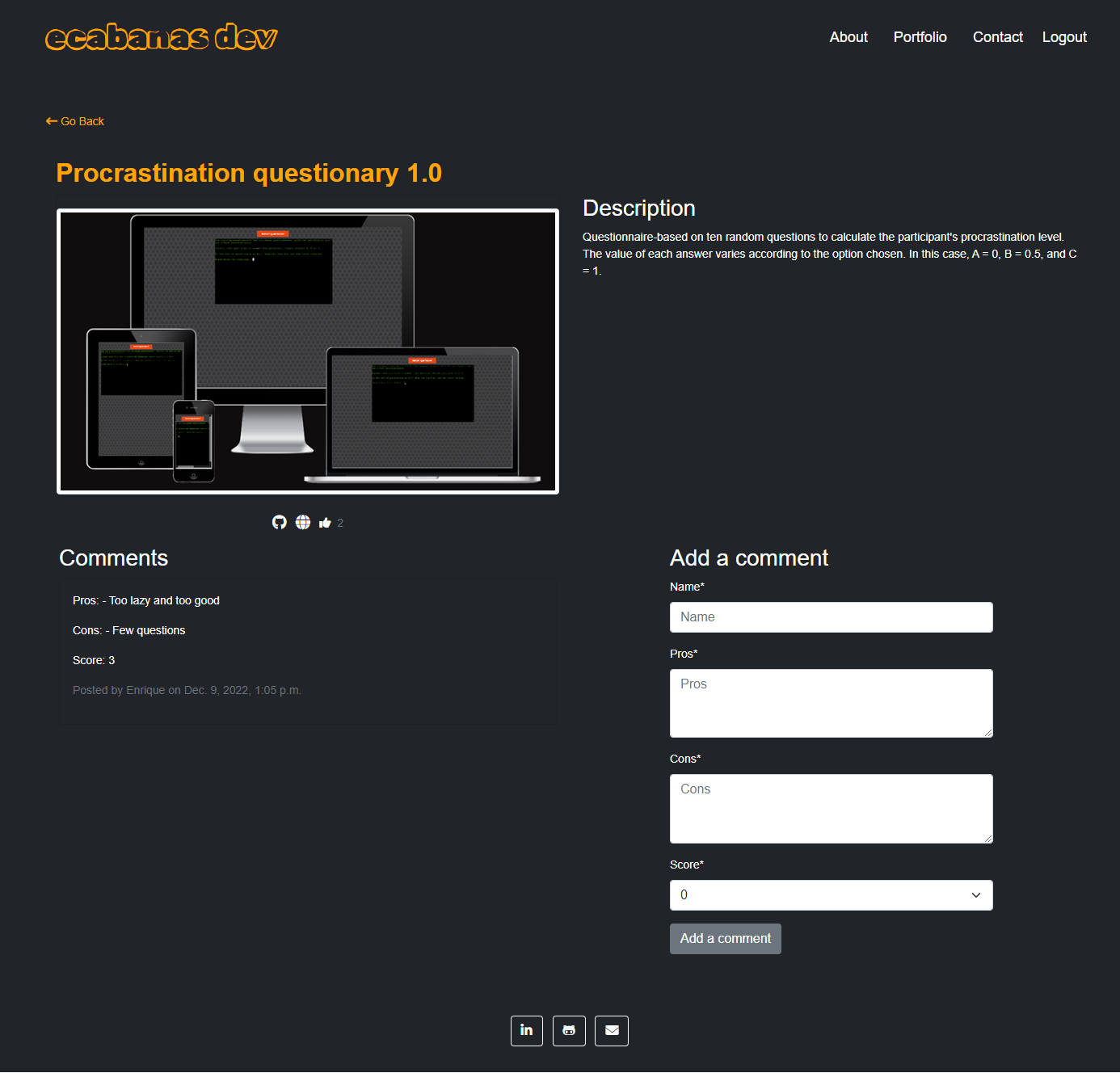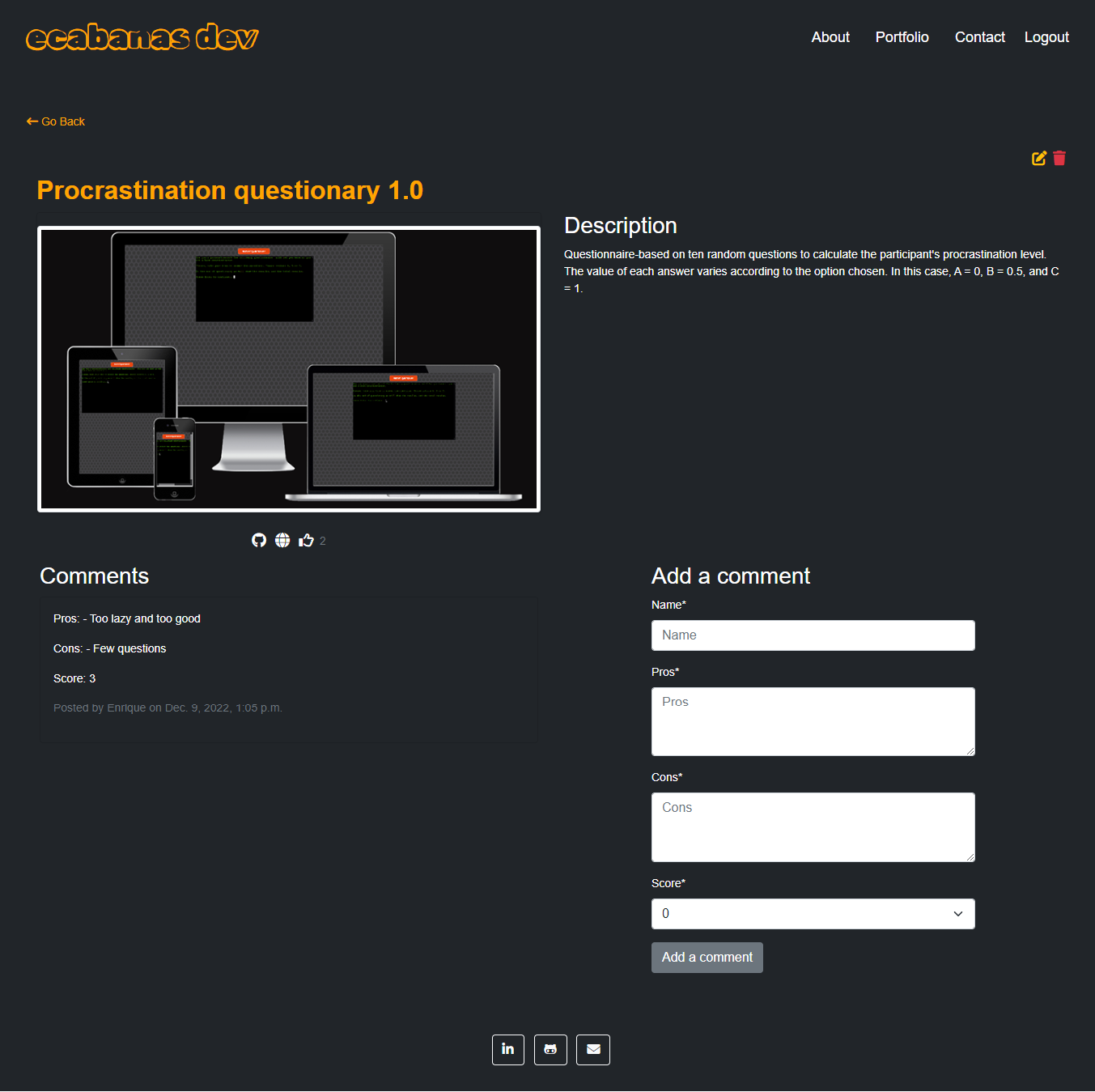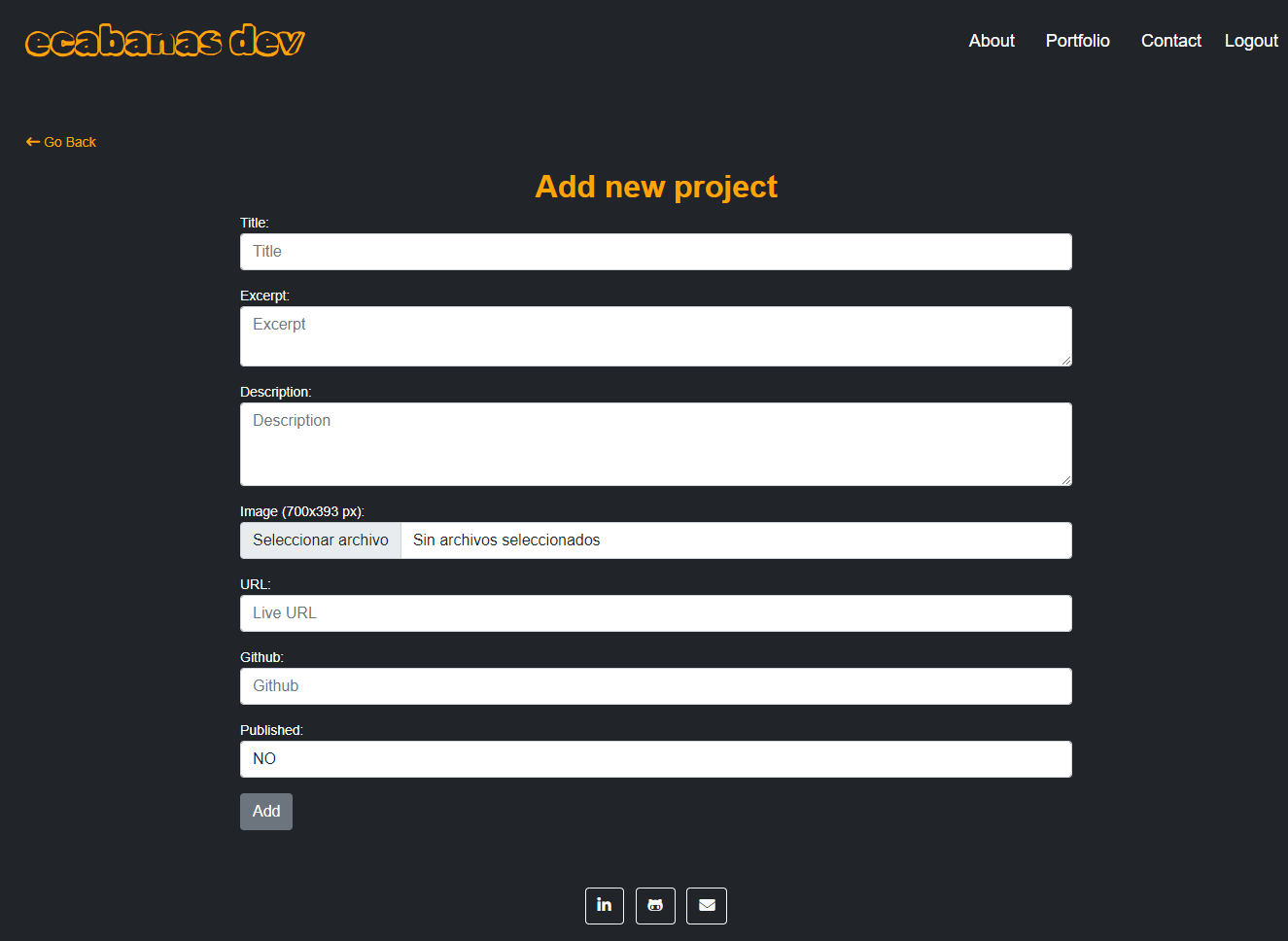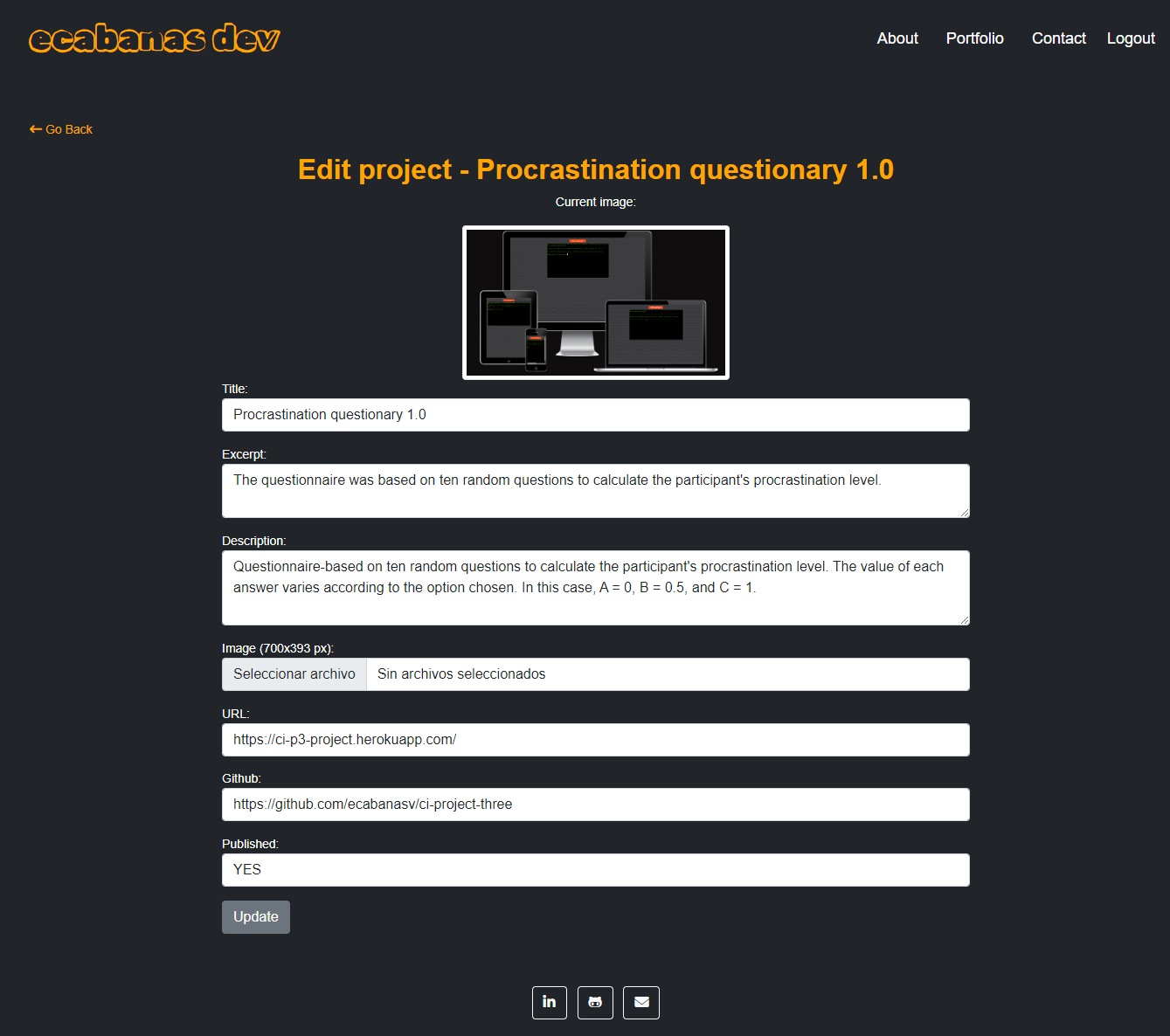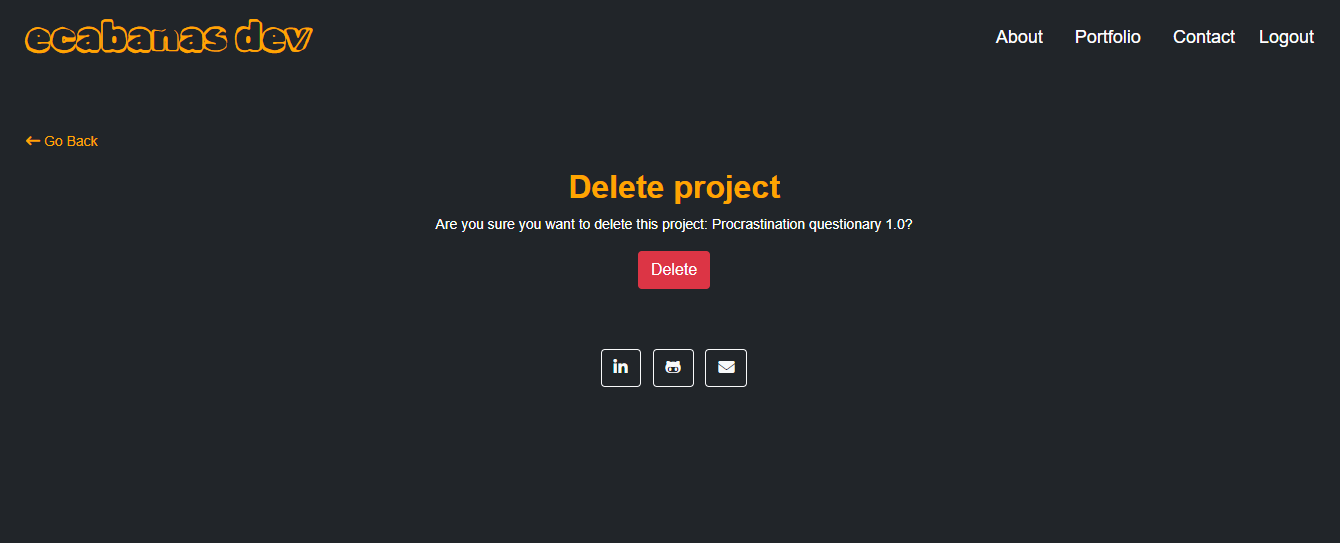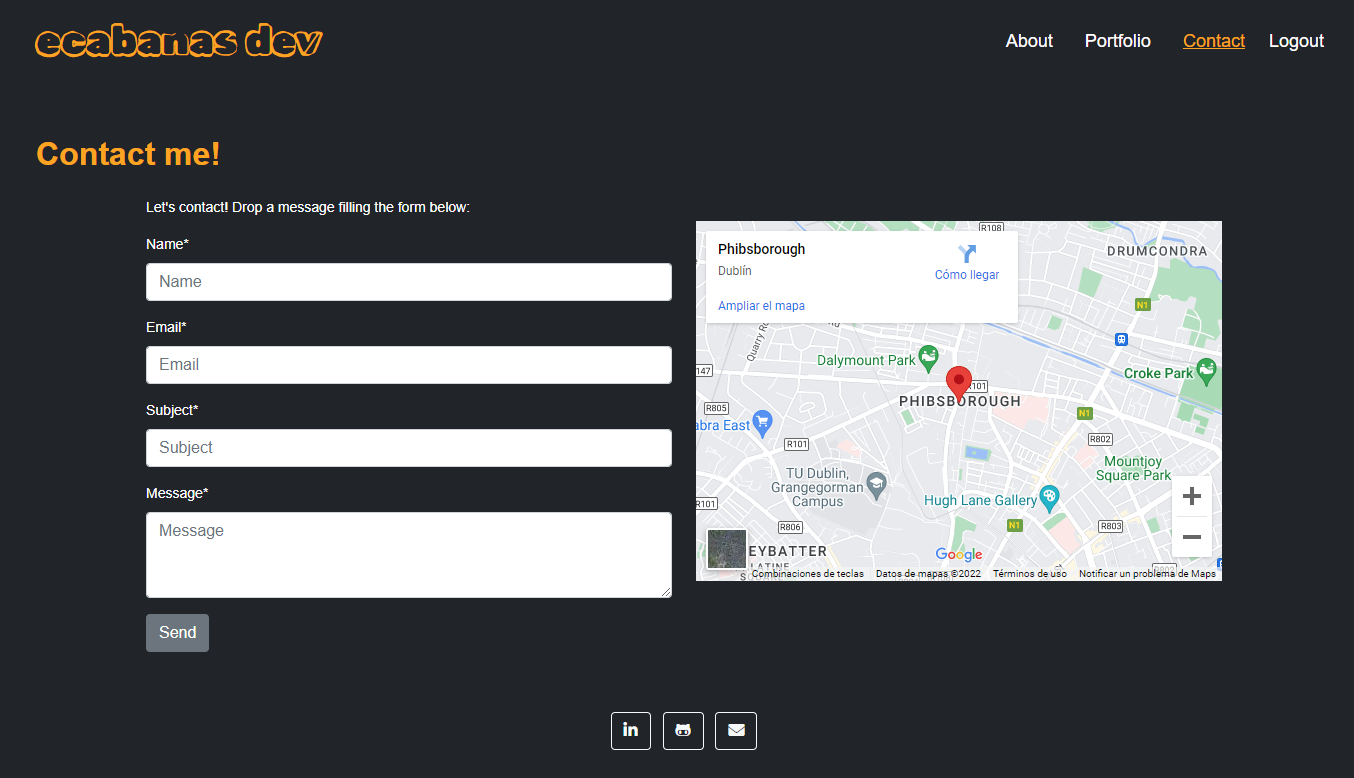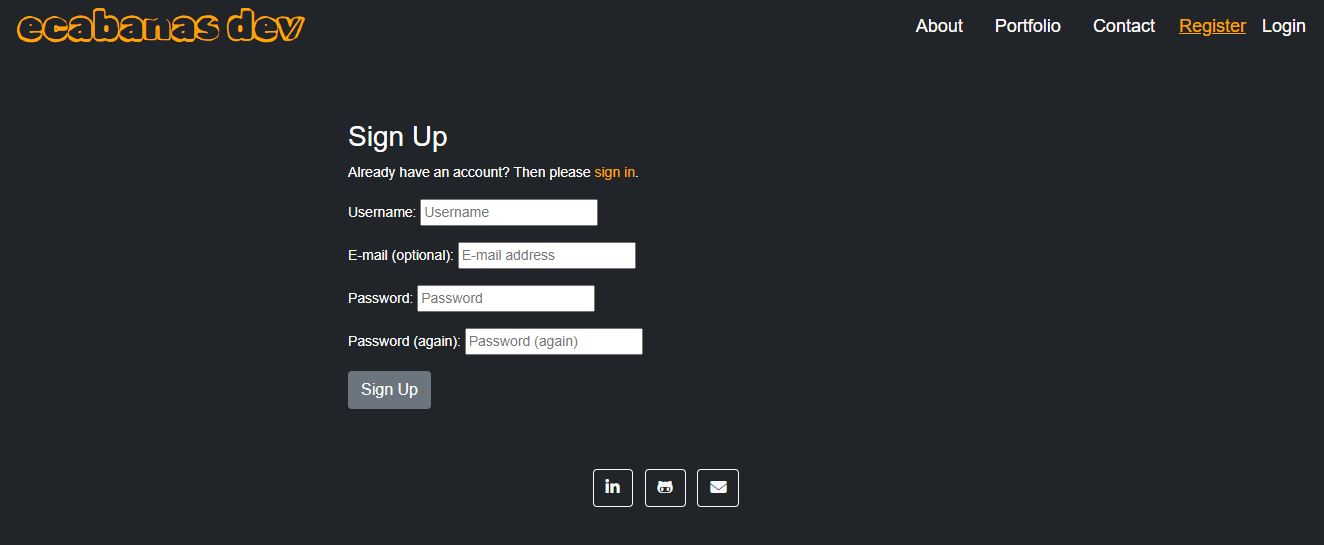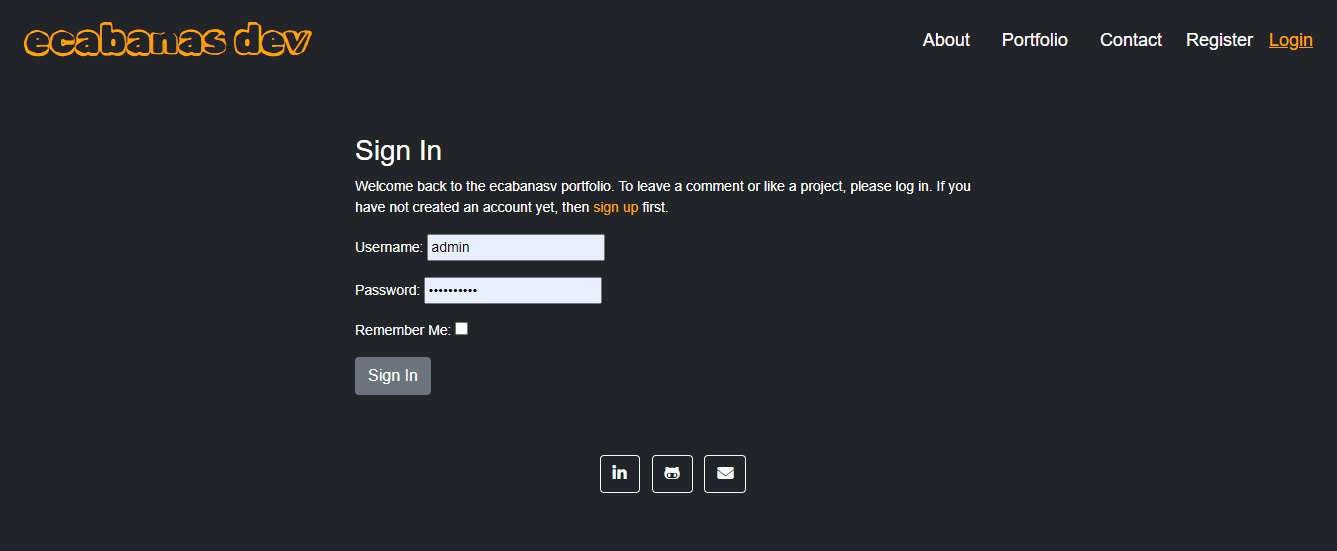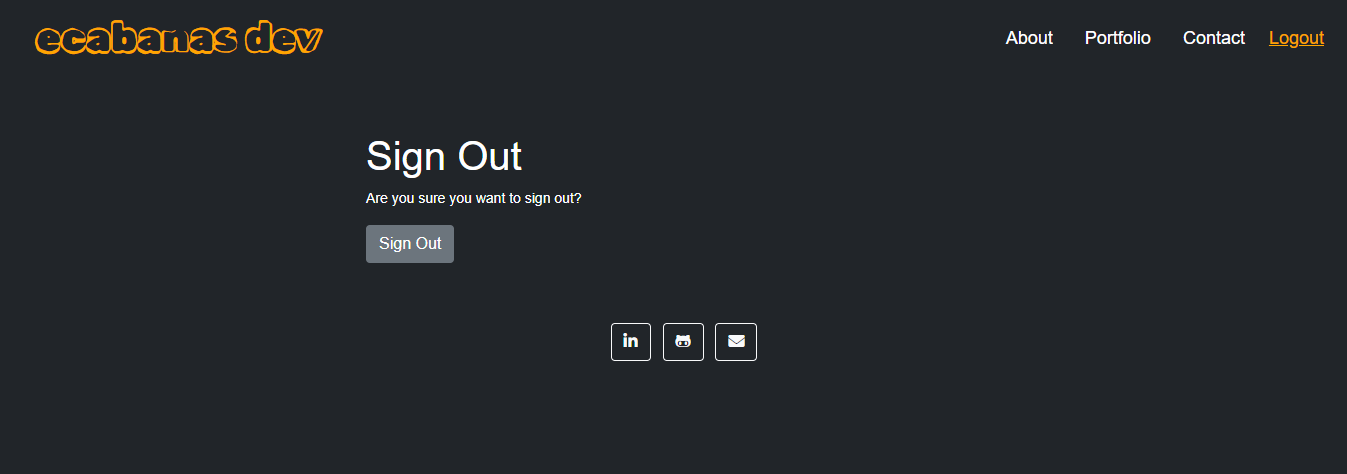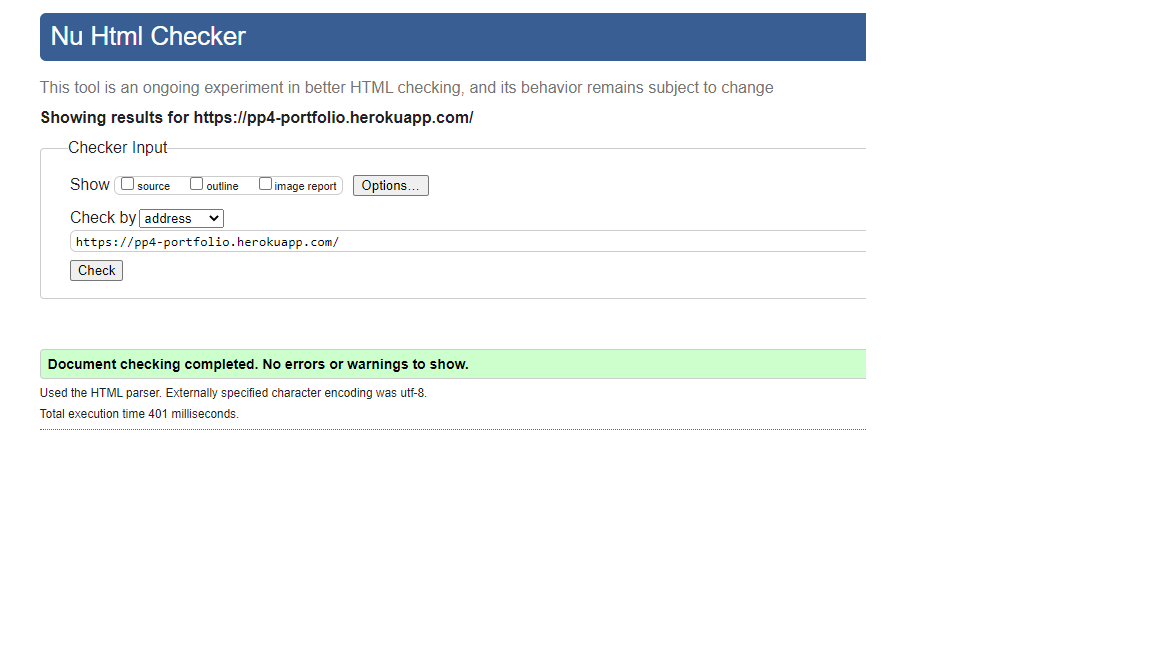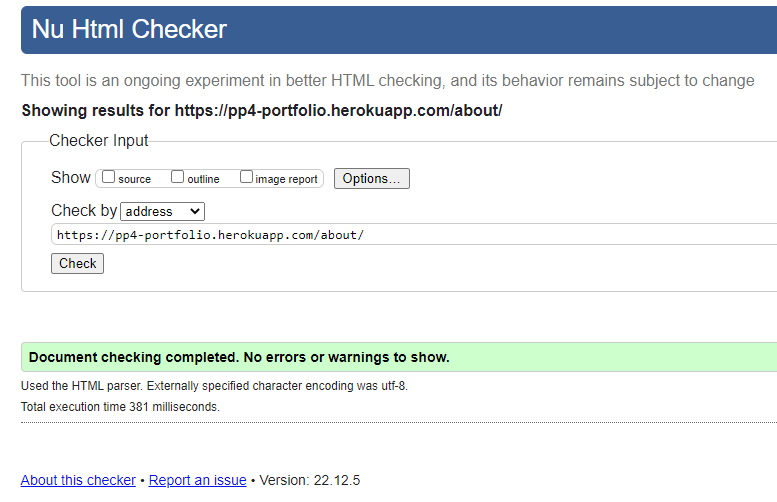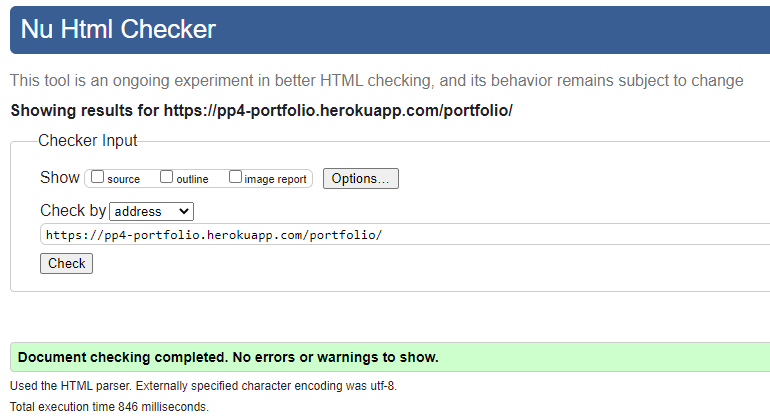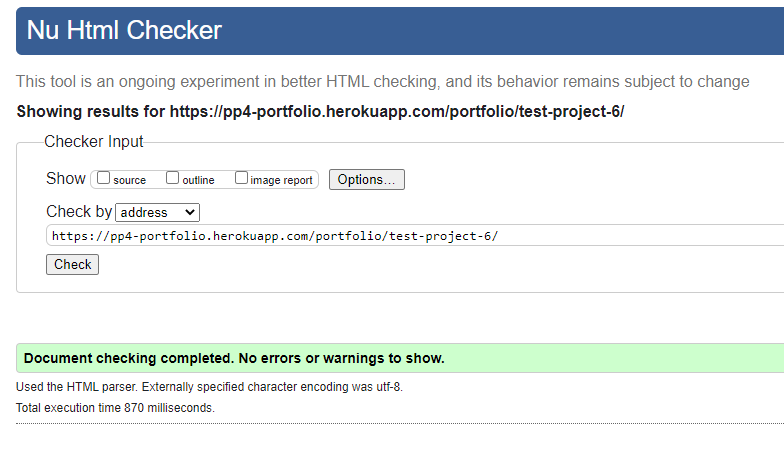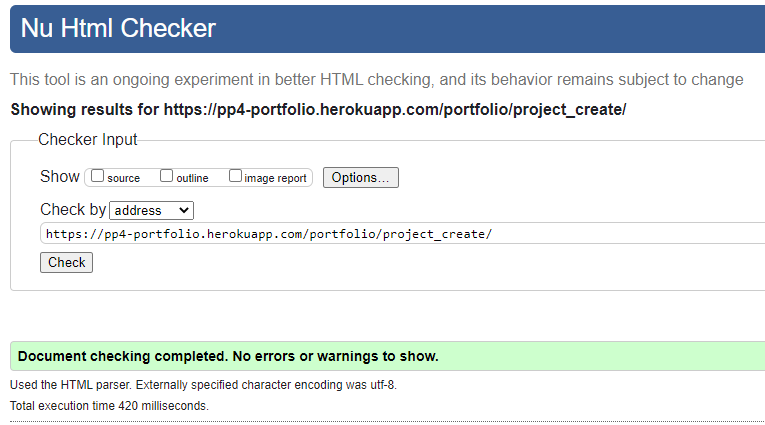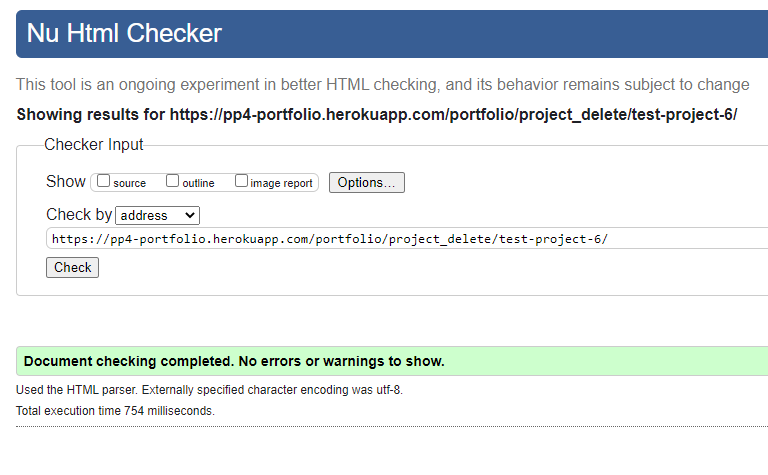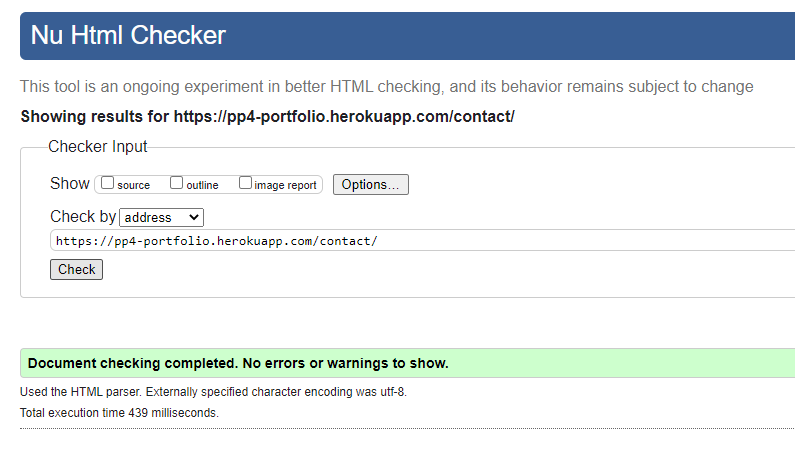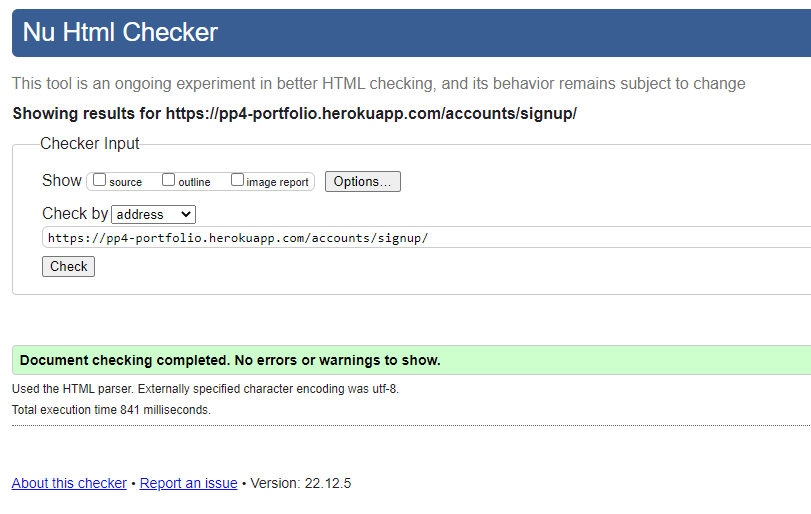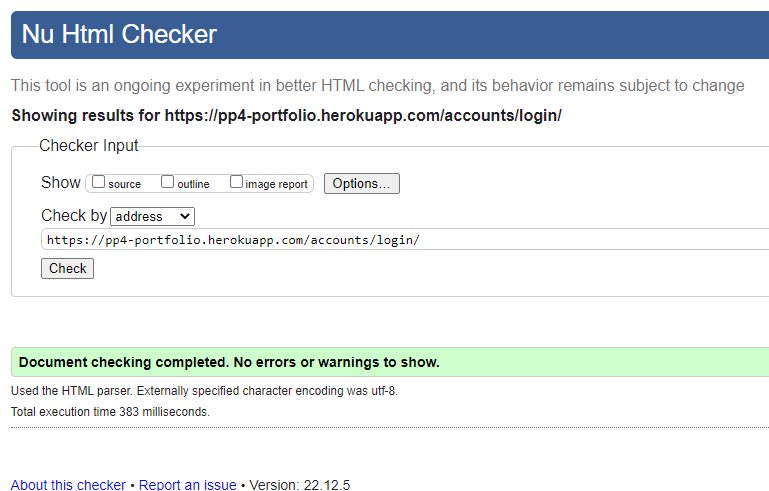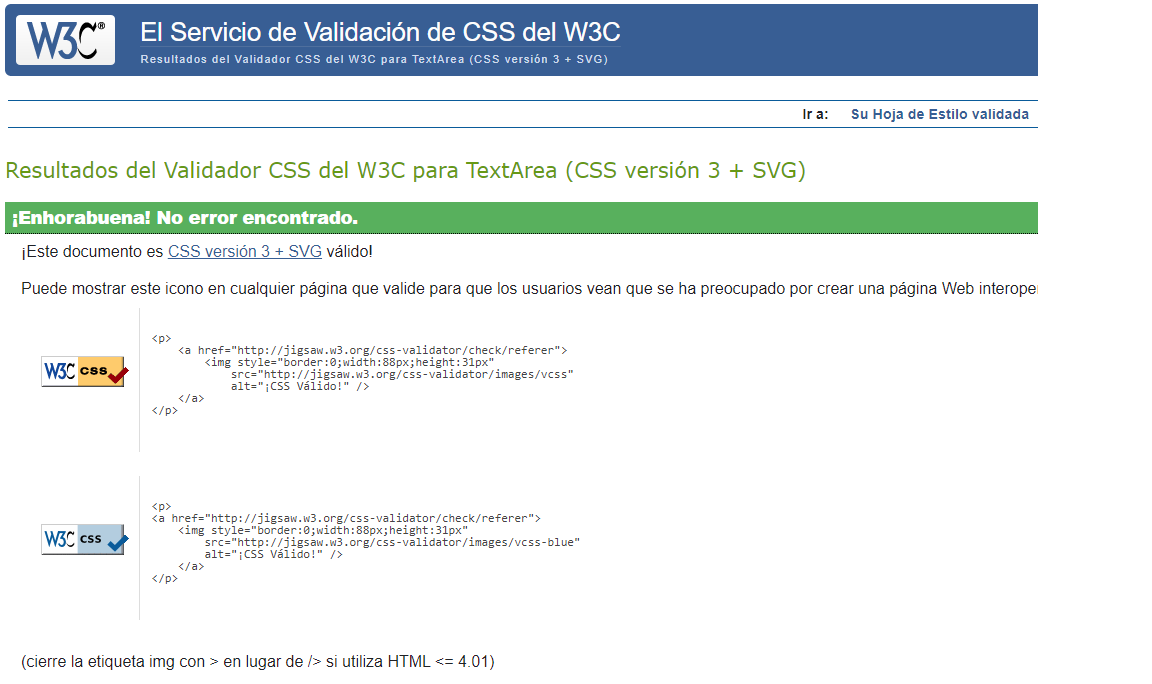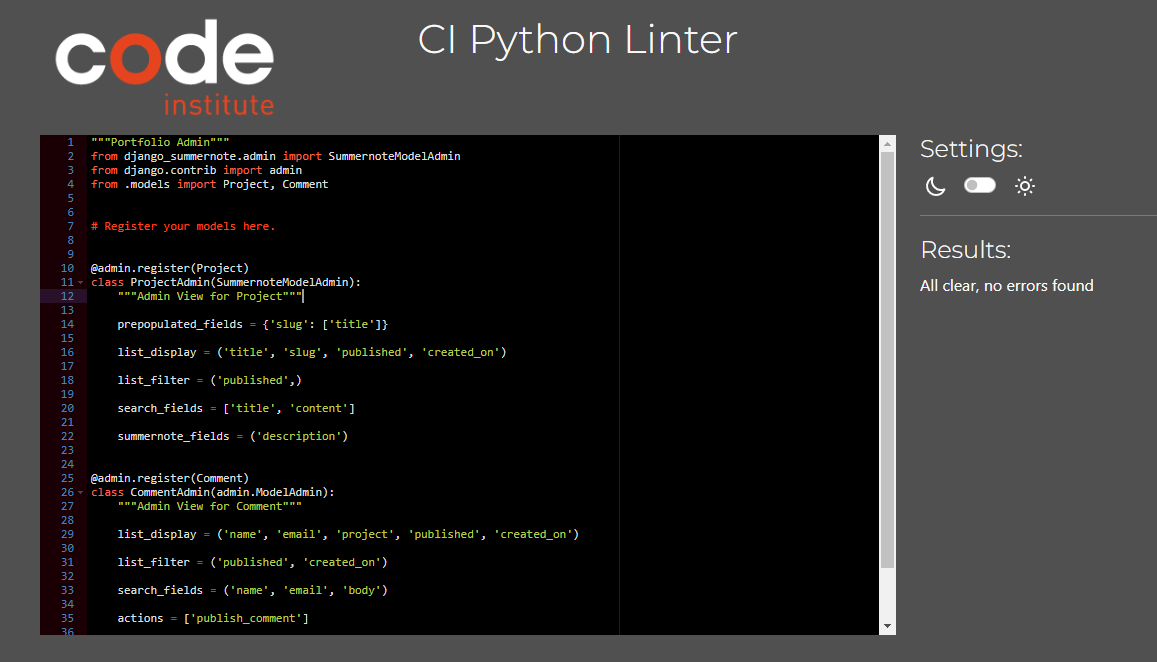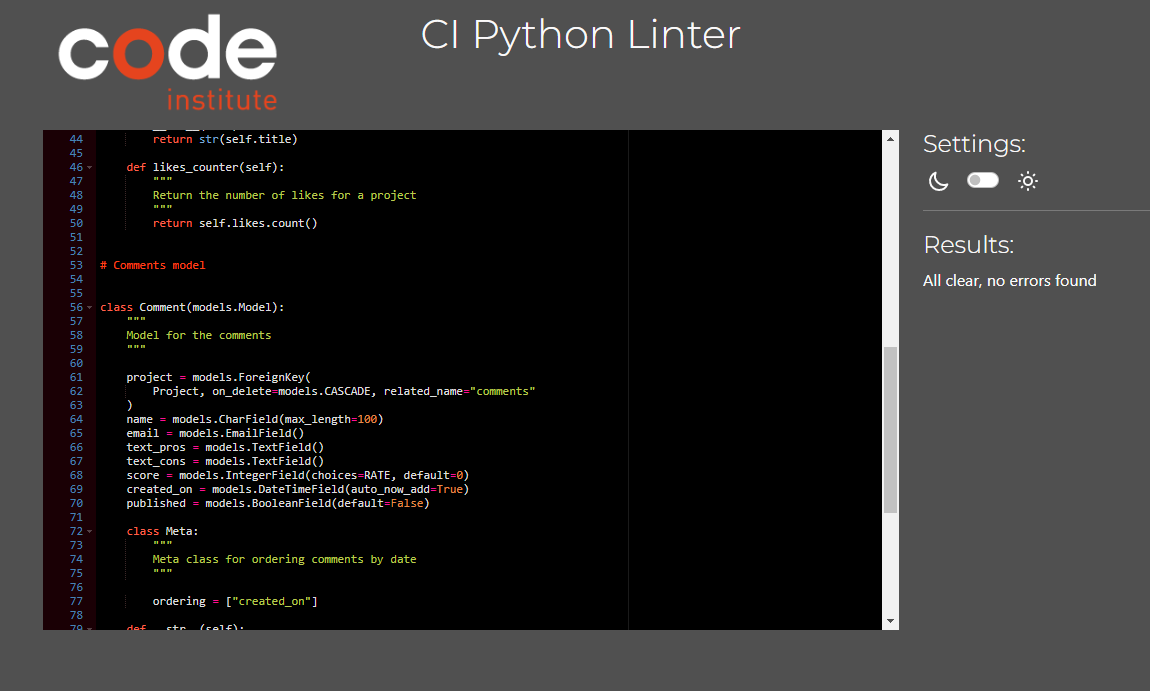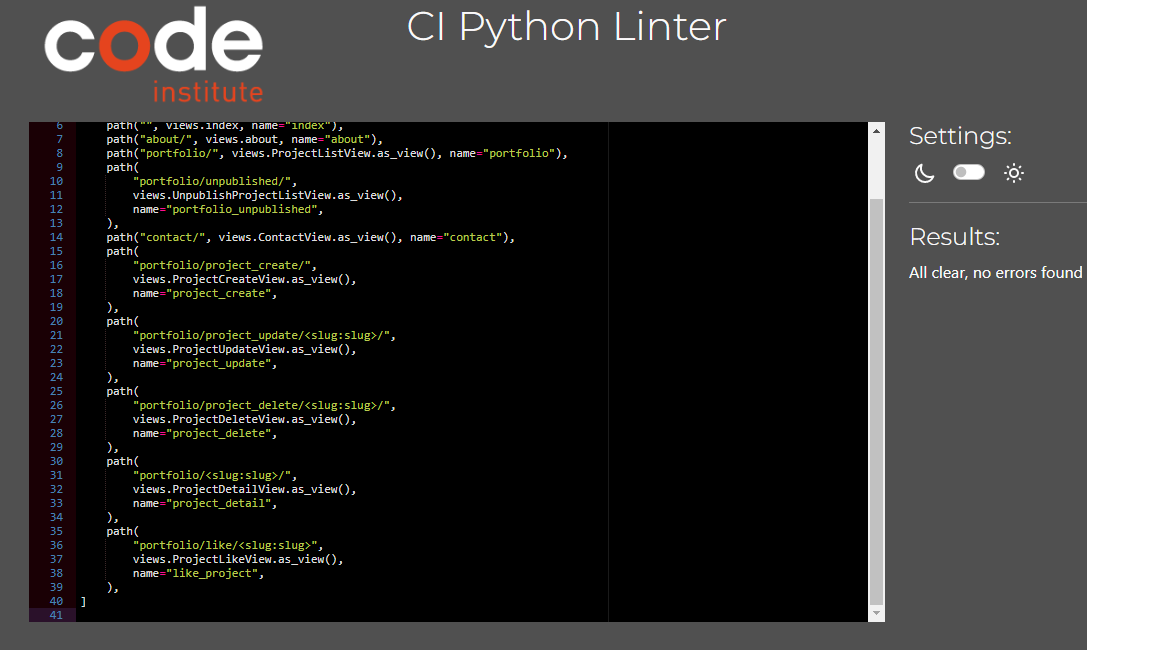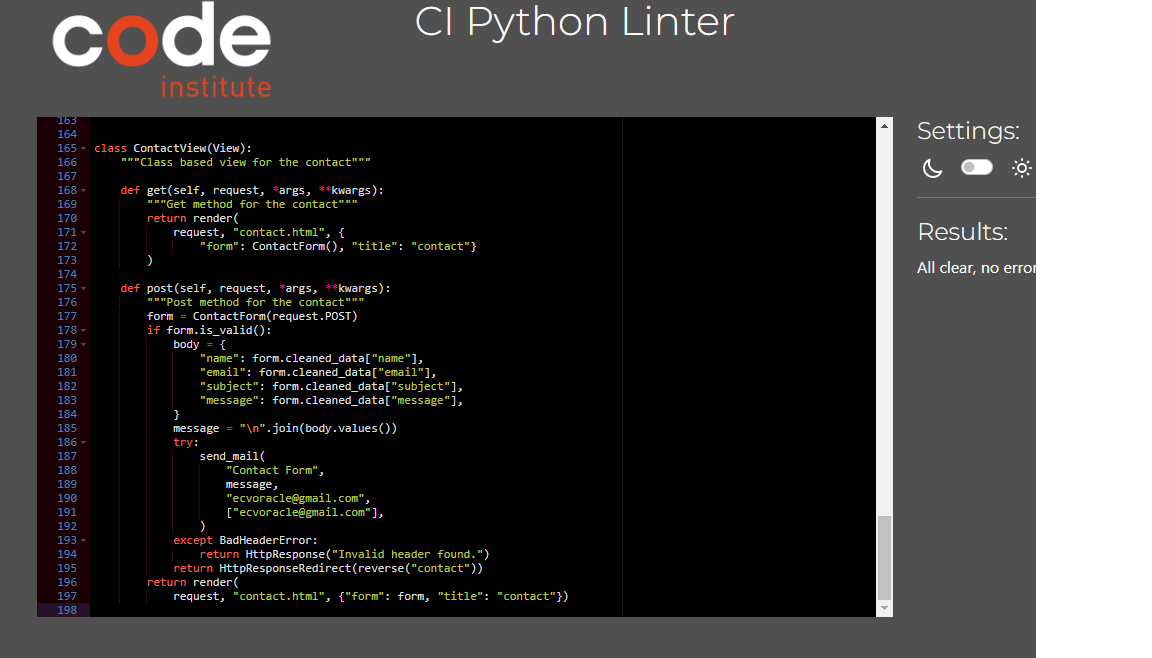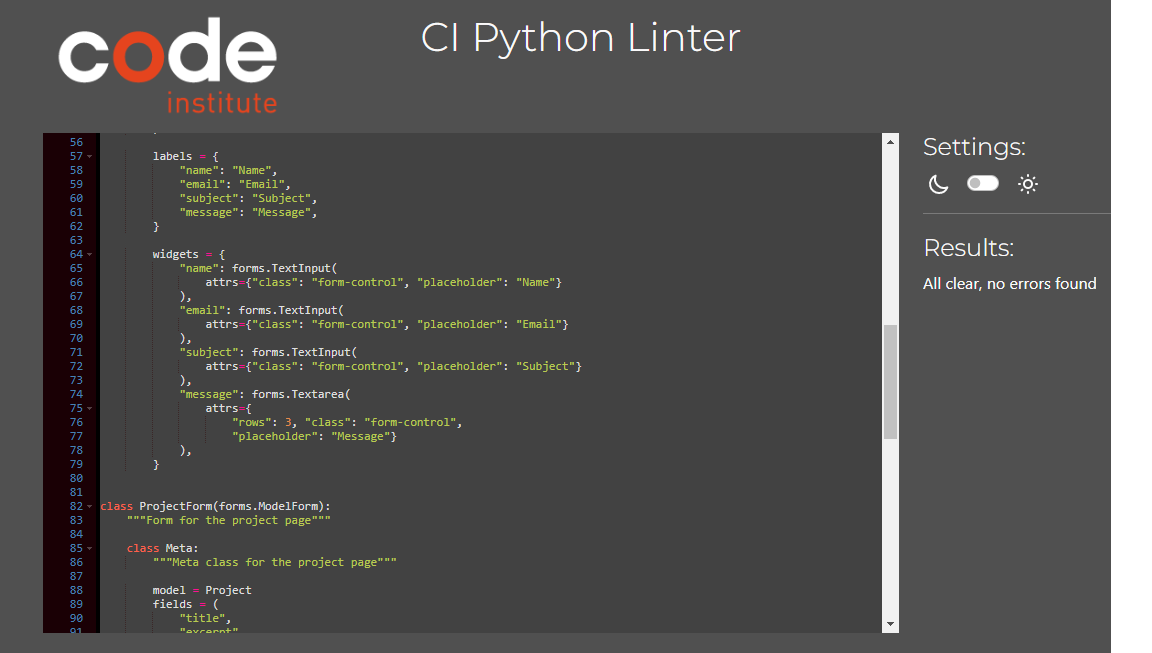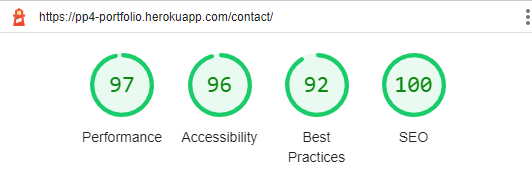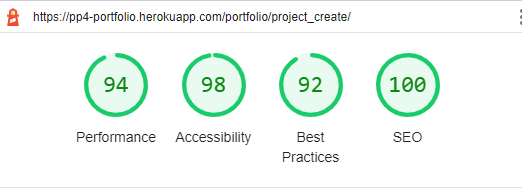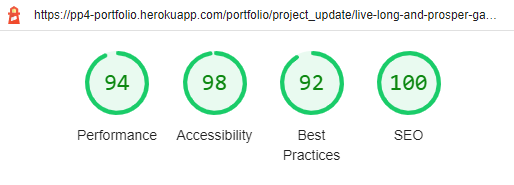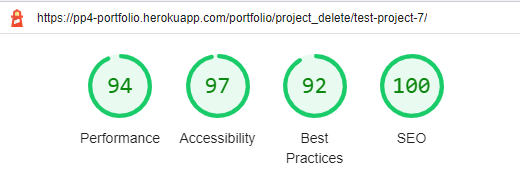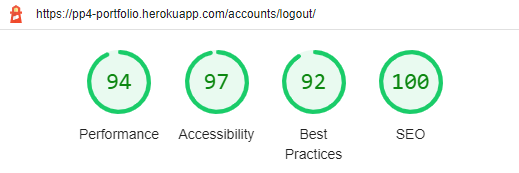Welcome to my fourth project. This project is a simple portfolio, allow users to vote and comment projects. This will use languages such as Django, Python, HTML, CSS and JavaScript.
This project will show the use of CRUD functionality (Create, Read, Update, Delete). The admin will be able create, read, update and delete their projects.
A live website can be found here.
First-Time Visitor Goals
- As a first-time visitor, I want to see portfolio projects.
- As a first-time visitor, I want to see the project details.
- As a first-time visitor, I want to see the project user comments.
- As a first-time visitor, I want to see the project user likes.
- As a first-time visitor, I want to view the contact menu.
- As a first-time visitor, I want to be able to register on the website as a user.
Returning Visitor Goals
- As a Returning Visitor, I can login with my registered user.
- As a Returning Visitor, I can comment on published projects.
- As a Returning Visitor, I can like/dislike projects.
Frequent User Goals
- As a Frequent User, I want to check if there are any new projects.
- As a Frequent User, I want to check if there are any new comments on projects.
Admin User Goals
- As an admin, I want to manage projects (create, publish/unpublish, update and delete)
- As an admin, I want to manage projects comments (publish and delete)
- The design should be clear and clean.
- Easy navigation through the different pages.
- Compatible with all browsers.
- Responsive design and adaptable to all devices.
- Have the possibility of contacting the developer for any questions.
The project has been managed using the GitHub project boards tool. It is a very useful tool to classify the different tasks to be carried out in the project.
Link to user stories here
The colour scheme of the project is quite simple and clean. The following colours used are presented below:
- Background: #212529
- Text: white
- Links: orange
- Hover link: yellow
The colour palette can be seen through the following link.
Final database structure for the portfolio app:
"""
Models for the portfolio app
"""
from django.db import models
from django.contrib.auth.models import User
from cloudinary.models import CloudinaryField
PUBLISH = ((0, "NO"), (1, "YES"))
RATE = ((0, "0"), (1, "1"), (2, "2"), (3, "3"), (4, "4"), (5, "5"))
class Project(models.Model):
"""
Model for the project
"""
title = models.CharField(max_length=250, unique=True)
slug = models.SlugField(max_length=250, unique=True)
author = models.ForeignKey(
User, on_delete=models.CASCADE, related_name="project_posts"
)
image_main = CloudinaryField("image", default="placeholder")
excerpt = models.TextField(blank=True)
description = models.TextField()
github_url = models.URLField(max_length=200)
live_url = models.URLField(max_length=200)
created_on = models.DateTimeField(auto_now_add=True)
updated_on = models.DateTimeField(auto_now=True)
published = models.IntegerField(choices=PUBLISH, default=0)
likes = models.ManyToManyField(
User, related_name="project_likes", blank=True)
# Meta class for ordering projects by date
class Meta:
"""
Meta class for ordering projects by date
"""
ordering = ["-created_on"]
def __str__(self):
return str(self.title)
def likes_counter(self):
"""
Return the number of likes for a project
"""
return self.likes.count()
# Comments model
class Comment(models.Model):
"""
Model for the comments
"""
project = models.ForeignKey(
Project, on_delete=models.CASCADE, related_name="comments"
)
name = models.CharField(max_length=100)
email = models.EmailField()
text_pros = models.TextField()
text_cons = models.TextField()
score = models.IntegerField(choices=RATE, default=0)
created_on = models.DateTimeField(auto_now_add=True)
published = models.BooleanField(default=False)
class Meta:
"""
Meta class for ordering comments by date
"""
ordering = ["created_on"]
def __str__(self):
return (
"Pros: {self.text_pros}"
+ "Cons: {self.text_cons}"
+ "Score: {self.score}"
+ "By: {self.name}"
)
class Contact(models.Model):
"""
Model for the contact
"""
name = models.CharField(max_length=100)
email = models.EmailField()
subject = models.CharField(max_length=100)
message = models.TextField()
def __str__(self):
return str(self.name)Desktop (click here to view)
Index:
About:
Portfolio - 1st page:
Portfolio - 2nd page:
Portfolio - Admin:
Portfolio - Unpublished:
Project details:
Project details - user:
Project details - admin:
Add new project:
Update project:
Delete project:
Contact:
Signup:
Login:
Logout:
Mobile (click here to view)
Index:
About:
Portfolio:
Portfolio - admin:
Portfolio - unpublished:
Project details:
Project details - user:
Project details - admin:
Add new project:
Update project:
Delete project:
Contact:
Signup:
Login:
Logout:
The navbar is positioned at the top and is visible on all web pages.
Navbar - desktop:
Navbar - mobile:
The messages will appear below the navbar whenever the user executes the actions of commenting, liking/unlike project, adding/editing/deleting a project, login/logout user session or sends a message through the contact form. Messages:
The footer element is present on all web pages and contains links to LinkedIn profiles, GitHub and another to send an email to the developer.
Footer:
Landing page of the project with a simple description, an image related to web development and a button that leads to the contact form.
Index:
Page with a short description of the developer and a personal main photo.
About:
The application's main page is where the different projects added and published are presented.
The presentation of the projects has been paginated to 6 projects per page.
You will see the main image of the project, the title of the project and the links to the GitHub repository, a live URL link and another button that goes to the details of the project.
The following is the visualization for the different types of users:
User:
Admin:
The superuser (admin) will display project management options, such as add, edit and delete projects. Also two buttons: One to view unpublished projects and another to manage project comments.
Admin comments:
When there are more than six projects in the portfolios (published and unpublished), the pagination button will be displayed (image below)
Pagination:
The page where unpublished projects will be displayed with the same administrator options as the published portfolio page.
Portfolio unpublished:
The project details page will allow registered users the following options: send comments and like/dislike.
Project details (non user):
Project details (user):
The administrator can access the options to edit and delete projects.
Project details (admin):
Form to add a project to the portfolio. The image, to maintain the consistency of the size of the thumbnails, will have to be 700x393 px. Selecting Published will be sent to the published or unpublished portfolio.
Add new project:
Form to edit a project to the portfolio. The image, to maintain the consistency of the size of the thumbnails, will have to be 700x393 px. Selecting Published will be sent to the published or unpublished portfolio. The display of the current image is added to have a reference when editing the image.
Update project:
Form to delete a project from the portfolio. It is presented with a simple button to confirm the deletion of the project.
Delete project:
Contact form and Google Maps image. EMAIL_BACKEND = 'django.core.mail.backends.console.EmailBackend' has been used to check the correct functioning of sending messages.
Contact:
Standard form for user registration.
Signup:
Standard form for user login.
Login:
Confirmation page to log out the user.
Logout:
- HTML5
- The project uses HyperText Markup Language.
- CSS3
- The project uses Cascading Style Sheets.
- JavaScript
- The project uses JavaScript.
- Python
- The project uses Python.
- Django
- The project uses Django framework for web development.
- Boostrap 5
- The project uses Bootstrap 5.
- Elephant SQL
- The project uses ElephantSQL as a database hosting.
- PostgreSQL
- The project uses PostgreSQL as a database.
- Visual Studio code
- The project uses Visual Studio code for developing.
- Firefox developer
- The project uses Firefox developer to debug and test the source code.
- Chrome
- The project uses Chrome Developer tools to test performance.
- Balsamiq
- Balsamiq was used to create the wireframes during the design process.
- Google Fonts
- Google fonts were used to import the "Be Vietnam Pro" font into the style.css file which is used on all pages throughout the project.
- GitHub
- GitHub was used to store the project's code after being pushed from Git.
Please login with the users below to test the project. One is superuser (admin) and another is regular user:
Admin (Username / Password)
- test_admin / uGmaHAhTw6ksD6P
User (Username / Password)
- test_dummy / uGmaHAhTw6ksD6P
Chrome DevTools is a set of web developer tools built directly into the Google Chrome browser. It was used in the project to test the performance of the different pages of the project. Also Lighthouse was used to check the accesibility of the web project.
Am I Responsive was used to make sure that all my pages are responsive to all devices.
Most of the the issues where related to "slash" that were removed from all the pages. Also there were not closed divs in portfolio and unpublished templates.
Index fails:
Index passed:
About:
Portfolio:
Project details:
Add project:
Delete project:
Contact:
Signup:
Login:
CSS Validator:
JavaScript validator:
Admin:
Models:
URLs:
Views:
Forms:
The project was tested with different browsers: Chrome, Safari, Firefox and Edge.
These include:
- iPhone X
- iPhone XS Max
- iPad Pro
- MacBook Pro
- POCO X3
| TEST | OUTCOME | PASS / FAIL |
|---|---|---|
| Logo button | When click direct to homepage | PASS |
| Navbar buttons | Nav links direct to their page | PASS |
| Footer links | Footer links direct to right page | PASS |
| Responsive | Design adapted to different devices | PASS |
| TEST | OUTCOME | PASS / FAIL |
|---|---|---|
| Index text | Show index text | PASS |
| Contact button | Direct to contact form when click | PASS |
| Image display | Displays the index image | PASS |
Lighthouse:
| TEST | OUTCOME | PASS / FAIL |
|---|---|---|
| About text | Show about text | PASS |
| Image display | Displays about image | PASS |
| CV gdrive link | Direct to gdrive link | PASS |
Lighthouse:
| TEST | OUTCOME | PASS / FAIL |
|---|---|---|
| Project display | Display published/unpublished projects | PASS |
| Project image | Display project main image | PASS |
| Title | Show project title | PASS |
| Github url | Show right Github URL | PASS |
| Live url | Show right live URL | PASS |
| Info url | Show right project info URL | PASS |
| Pagination | Pagination works when there are more than 6 projects | PASS |
| Published/Unpublished btn | Unpublished btn show when admin user logged | PASS |
| Admin comments btn | Admin comments btn show when admin user logged | PASS |
| Add project btn | Add project show when admin user logged | PASS |
| Edit project btn | Edit project show when admin user logged | PASS |
| Delete project btn | Delete project show when admin user logged | PASS |
| Message | Display message when add/edit/delete project | PASS |
Lighthouse:
| TEST | OUTCOME | PASS / FAIL |
|---|---|---|
| Main image | Shows main project image | PASS |
| Title | Shows project title | PASS |
| Description | Shows project description | PASS |
| Edit project btn | Edit project show when admin user logged | PASS |
| Delete project btn | Delete project show when admin user logged | PASS |
| Like/Unlike | When user is registered user can like/dislike | PASS |
| Like counter | Shows like counter | PASS |
| Comment form | When user is registered shows comment form | PASS |
| Message | Display message when add/edit/delete project | PASS |
| Go back | When click Go Back redirect to Portfolio | PASS |
Lighthouse:
| TEST | OUTCOME | PASS / FAIL |
|---|---|---|
| Contact form | Shows contact form | PASS |
| Send message | Functionality works when send form | PASS |
| Shows map | Shows Google Map iframe | PASS |
| Message | Display message send message | PASS |
Lighthouse:
| TEST | OUTCOME | PASS / FAIL |
|---|---|---|
| Shows Add project form | Shows add project form | PASS |
| Add project completed | When click add project is added | PASS |
| Go back | When click Go Back redirect to Portfolio | PASS |
Lighthouse:
| TEST | OUTCOME | PASS / FAIL |
|---|---|---|
| Shows Update project form | Shows update project form | PASS |
| Add project completed | When click update project is updated | PASS |
| Current image | Shows current project image | PASS |
| Go back | When click Go Back redirect to Portfolio | PASS |
Lighthouse:
| TEST | OUTCOME | PASS / FAIL |
|---|---|---|
| Shows Delete project form | Shows delete project form | PASS |
| Delete project completed | When click delete project is deleted | PASS |
| Go back | When click Go Back redirect to Portfolio | PASS |
Lighthouse:
| TEST | OUTCOME | PASS / FAIL |
|---|---|---|
| Display Signup form | Shows form correctly | PASS |
| Signup action | User is correctly registered | PASS |
| Message | Display message when signup | PASS |
Lighthouse:
| TEST | OUTCOME | PASS / FAIL |
|---|---|---|
| Display Login form | Shows form correctly | PASS |
| Login action | User is correctly logged | PASS |
| Message | Display message when login | PASS |
Lighthouse:
| TEST | OUTCOME | PASS / FAIL |
|---|---|---|
| Display logout form | Shows form correctly | PASS |
| Logout action | User is logout | PASS |
| Message | Display message when logout | PASS |
Lighthouse:
- DEBUG set to true when deploy the project to Heroku.
- Fixed all the divs in portfolio/unpublished that were not closed.
- Fixed the project images to 700x393 px in order to display them correcly in portfolio.
- Centered rows and col with d-flex justify-content-center instead of no using d-flex.
- If development if being done locally: Activate your virtual environment
- To ensure the virtual environment is not tracked by version control, add .venv to the .gitignore file.
- Install Django and gunicorn:
pip install django gunicorn - Install supporting database libraries dj_database_url and psycopg2 library:
pip install dj_database_url psycopg2 - Install Cloudinary libraries to manage static files:
pip install dj-3-cloudinary-storage - Create file for requirements:
pip freeze --local > requirements.txt - Create project:
django-admin startproject project_name . - Create app:
python manage.py startapp app_name - Add app to list of
installed appsin settings.py file:'app_name' - Migrate changes:
python manage.py migrate - Test server works locally:
python manage.py runserver
- Navigate to the Heroku website
- Create a Heroku account by entering your email address and a password (or login if you have one already).
- Activate the account through the authentication email sent to your email account
- Click the new button on the top right corner of the screen and select create a new app from the dropdown menu.
- Enter a unique name for the application.
- Select the appropriate region for the application.
- Click create app
- In the Heroku dashboard click on the Resources tab
- Scroll down to Add-Ons, search for and select 'Heroku Postgres'
- In the Settings tab, scroll down to 'Reveal Config Vars' and copy the text in the box beside DATABASE_URL.
- In you IDE create a new env.py file in the top level directory
- Add env.py to the .gitignore file
- In env.py import the os library
- In env.py add
os.environ["DATABASE_URL"]= "Paste in the text link copied above from Heroku DATABASE_URL" - In env.py add
os.environ["SECRET_KEY"] = "Make up your own random secret key" - In Heroku Settings tab Config Vars enter the same secret key created in env.py by entering 'SECRET_KEY' in the box for 'KEY' and your randomly created secret key in the 'value' box.
- In your Django 'settings.py' file type:
from pathlib import Path
import os
import dj_database_url
if os.path.isfile("env.py"):
import env
- Remove the default insecure secret key in settings.py and replace with the link to the secret key variable in Heroku by typing:
SECRET_KEY = os.environ.get(SECRET_KEY) - Comment out the
DATABASESsection in settings.py and replace with:
DATABASES = {
'default':
dj_database_url.parse(os.environ.get("DATABASE_URL"))
}`
- Create a Cloudinary account and from the 'Dashboard' in Cloudinary copy your url into the env.py file by typing:
os.environ["CLOUDINARY_URL"] = "cloudinary://<insert-your-url>" - In Heroku add cloudinary url to 'config vars'
- In Heroku config vars add DISABLE_COLLECTSTATIC with value of '1' (note: this must be removed for final deployment)
- Add Cloudinary libraries to the installed apps section of settings.py file:
'cloudinary_storage'
'django.contrib.staticfiles''
'cloudinary'
- Connect Cloudinary to the Django app in
settings.py:
STATIC_URL = '/static'
STATICFILES_STORAGE = 'cloudinary_storage.storage.StaticHashedCloudinaryStorage'
STATICFILES_DIRS = [os.path.join(BASE_DIR, 'STATIC')]
STATIC_ROOT = os.path.join(BASE_DIR, 'staticfiles')
MEDIA_URL = '/media/'
DEFAULT_FILE_STORAGE =
'cloudinary_storage.storage.MediaCloudinaryStorage'
* Link file to the templates directory in Heroku
* Place under the BASE_DIR: TEMPLATES_DIR = os.path.join(BASE_DIR,
'templates')
-
Change the templates directory to TEMPLATES_DIR. Place within the TEMPLATES array:
'DIRS': [TEMPLATES_DIR] -
Add Heroku Hostname to ALLOWED_HOSTS:
ALLOWED_HOSTS = ['rhi-book-nook.herokuapp.com', 'localhost']*Create Procfile at the top level of the file structure and insert the following:web: gunicorn PROJECT_NAME.wsgi -
Make an initial commit and push the code to the GitHub Repository.
git add .git commit -m "Initial deployment"git push
- Click Deploy tab in Heroku
- In the 'Deployment method' section select 'Github' and click the 'connect to Github' button to confirm.
- In the 'search' box enter the Github repository name for the project
- Click search and then click connect to link the heroku app with the Github repository. The box will confirm that heroku is connected to the repository.
In the IDE:
- When development is complete change the debug setting to:
DEBUG = Falseinsettings.py - In Heroku settings config vars change the DISABLE_COLLECTSTATIC value to 0
- Because DEBUG must be switched to True for development and False for production it is recommended that only manual deployment is used in Heroku.
- To manually deploy click the button 'Deploy Branch'. The default 'main' option in the dropdown menu should be selected in both cases. When the app is deployed a message 'Your app was successfully deployed' will be shown. Click 'view' to see the deployed app in the browser.
A copy of the GitHub Repository can be made by forking the GitHub account. Changes can be made on this copy without affecting the original repository.
- Log in to GitHub and locate the repository in question.
- Locate the Fork button which can be found in the top corner, right-hand side of the page, inline with the repository name.
- Click this button to create a copy of the original repository in your GitHub Account.
- Click on the code button which is underneath the main tab and repository name to the right.
- In the 'Clone with HTTPS' section, click on the clipboard icon to copy the URL.
- Open Git Bash in your IDE of choice.
- Change the current working directory to where you want the cloned directory to be made.
- Type git clone, and then paste the URL copied from GitHub.
- Press enter and the clone of your repository will be created.
I want to thanks to Kasia for all the follow ups during this time. And I also I want to thanks to my mentor all the great feedbacks and advises during the process.
Tool used to create the ERD diagram https://www.wplogout.com/export-database-diagrams-erd-from-django/
Tutorial used to set up favicon on web project https://learndjango.com/tutorials/django-favicon-tutorial
- Default image used in CI project walkthrough
- pngtree.com for the main index image

